Greek Art and Archaeology Quiz 2!!
1/54
There's no tags or description
Looks like no tags are added yet.
Name | Mastery | Learn | Test | Matching | Spaced |
|---|
No study sessions yet.
55 Terms
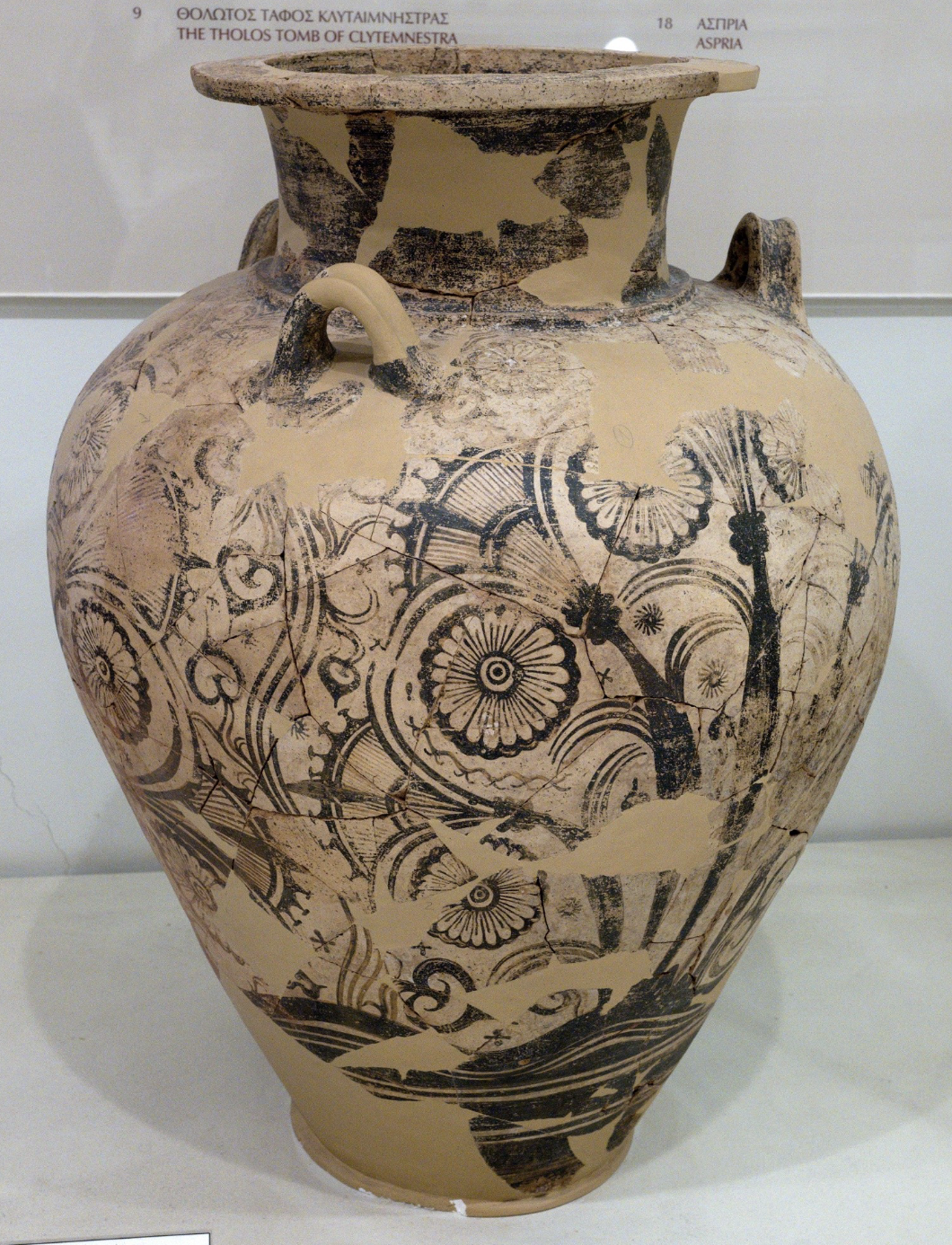
palace style (vessels of this style exported to Crete Mycenae from tomb)
LH 2
lustrous paint, Minoan influence

Ephyraean goblet
LH 2
lustrous paint
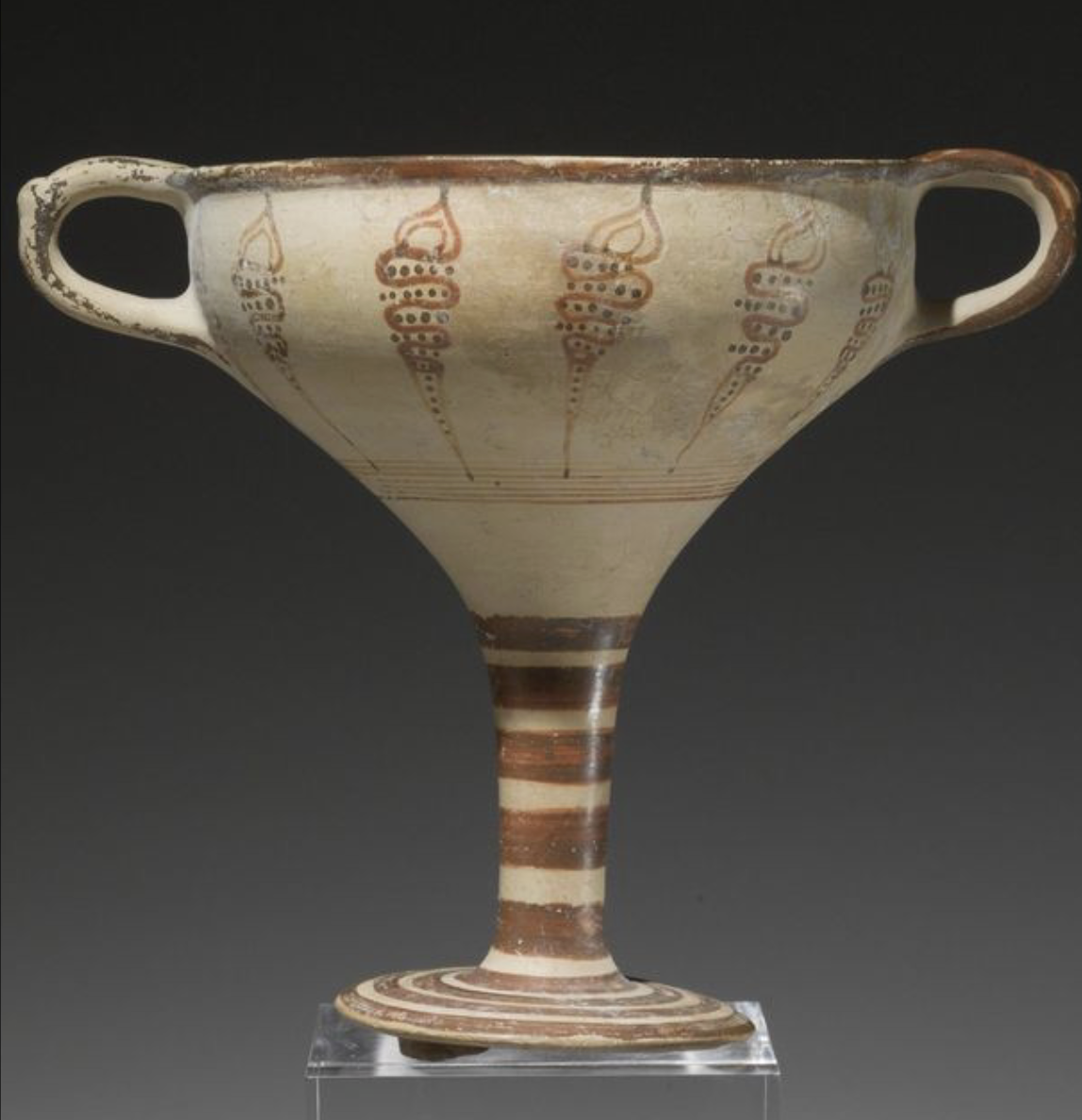
LH 3A
goblet is out and kylix is in!
whorl shell motif appears and the people love it

LH 3B
deep bowl appears!
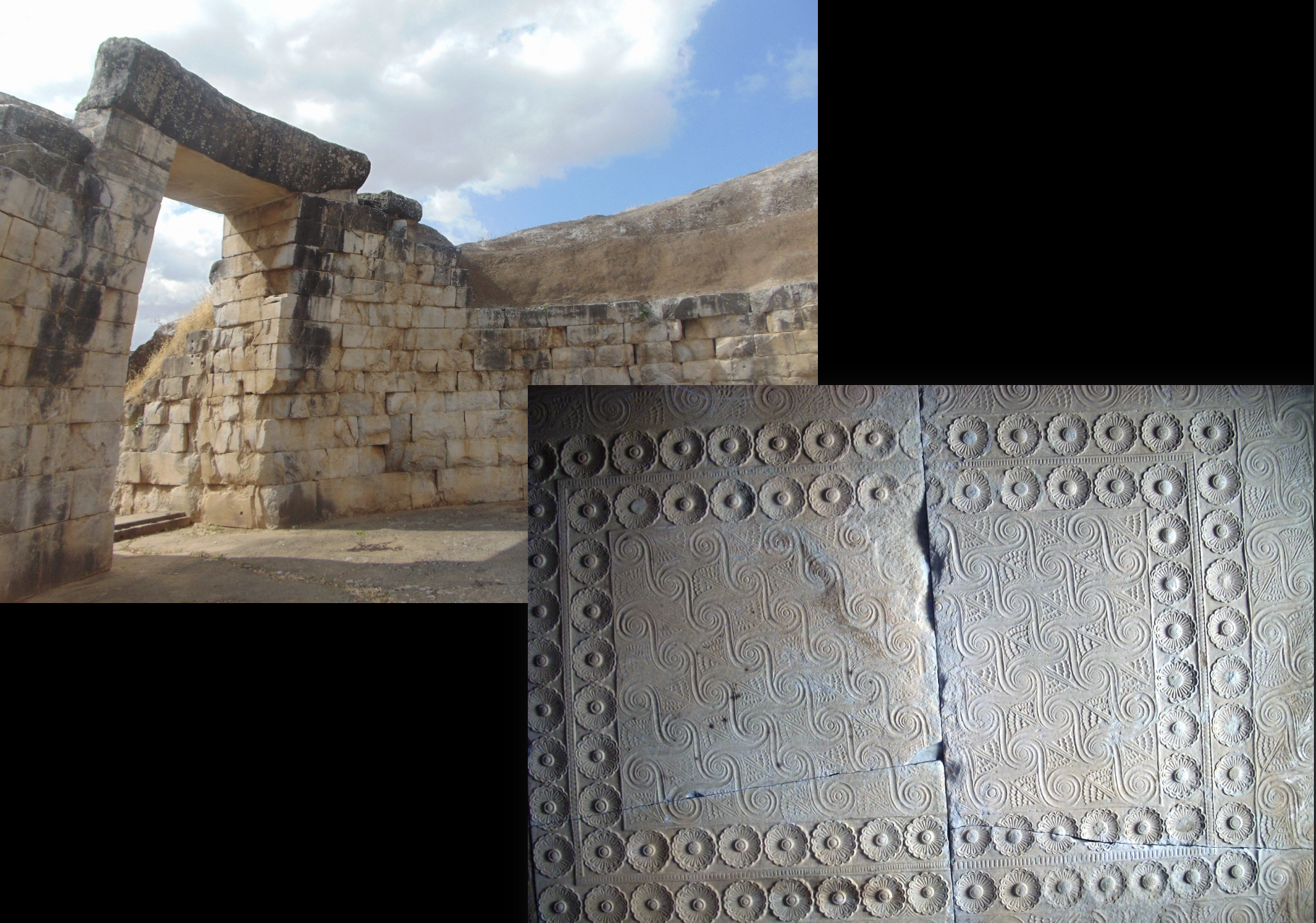
Treasury of Minyas
LH 3B
2nd pic is ceiling of antechamber — egyptian decorative motifs (quite reminiscent of tombs at Beni Hasan)
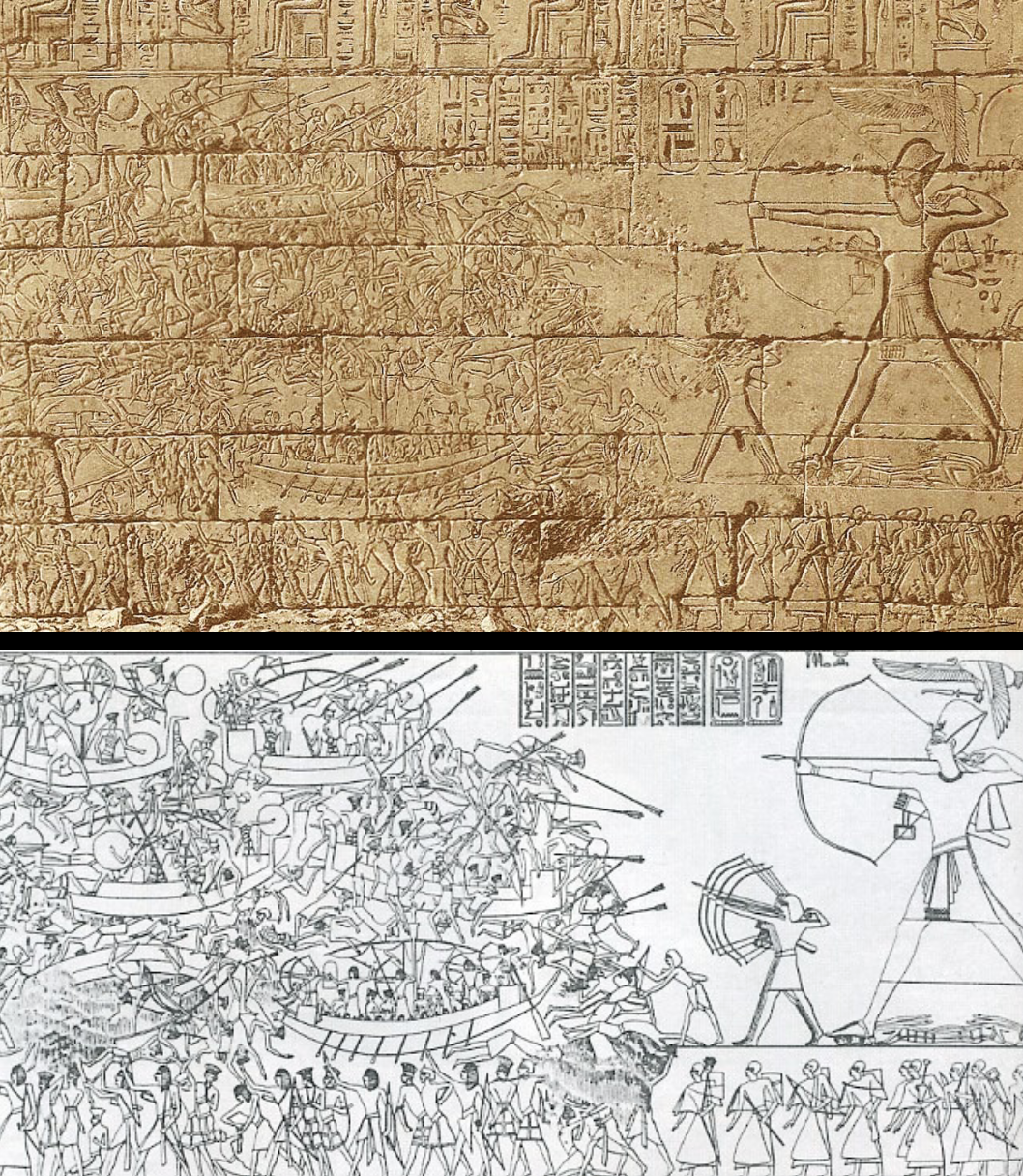
depiction of sea peoples attacking egypt
medinet habu inscription (essentially just talking abt how the sea people were creating chaos and descruption across egypt
funerary temple of Ramses 3rd
we don’t really know who the sea peoples are
so this points to bronze age collapse, which was caused by: external factors like sea peoples, environmental factors like drought, internal factors like civil unrest
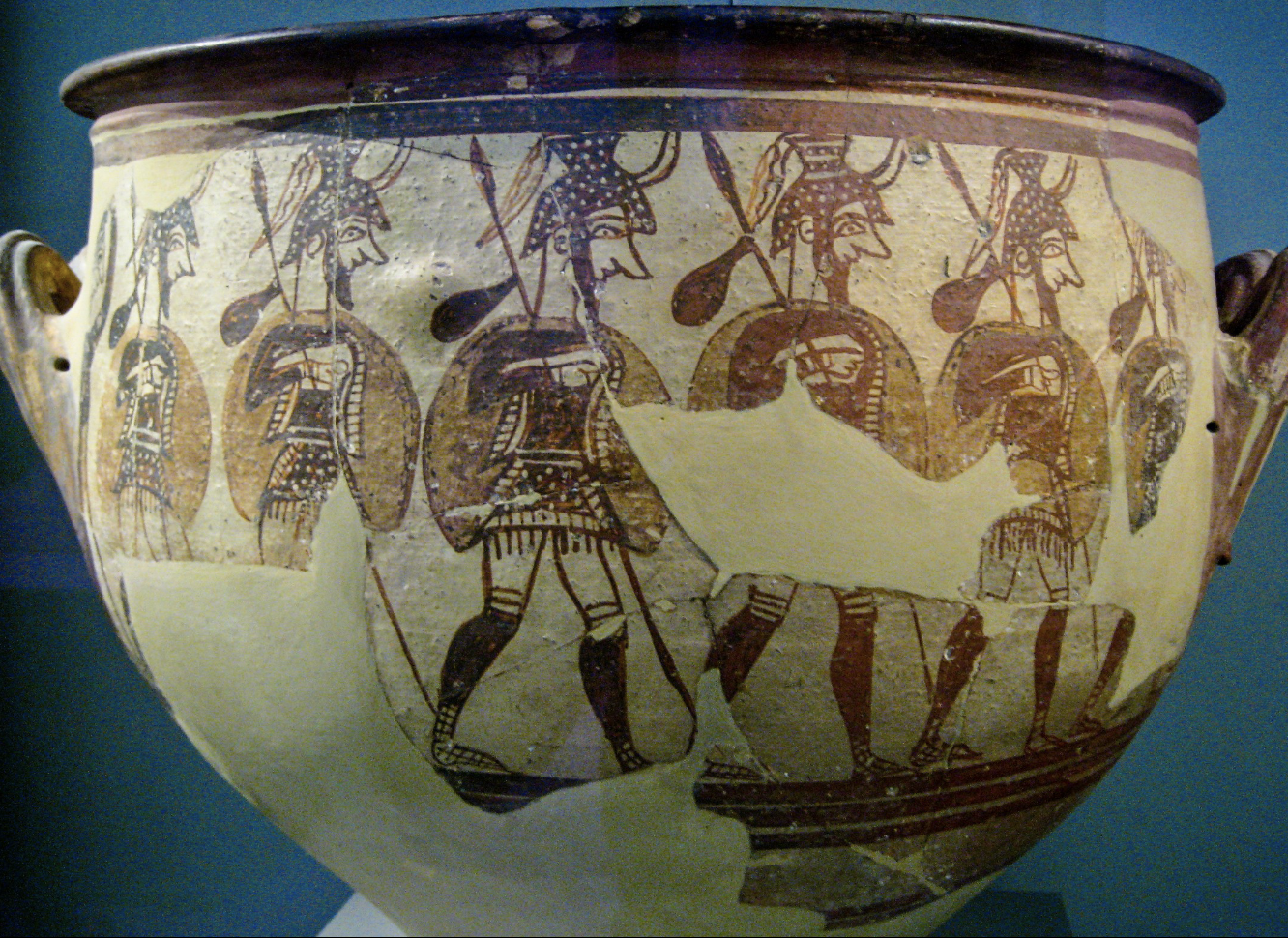
LH 3C (so its post palatial)
pictorial style
this is the warrior vase krater from Myceneae
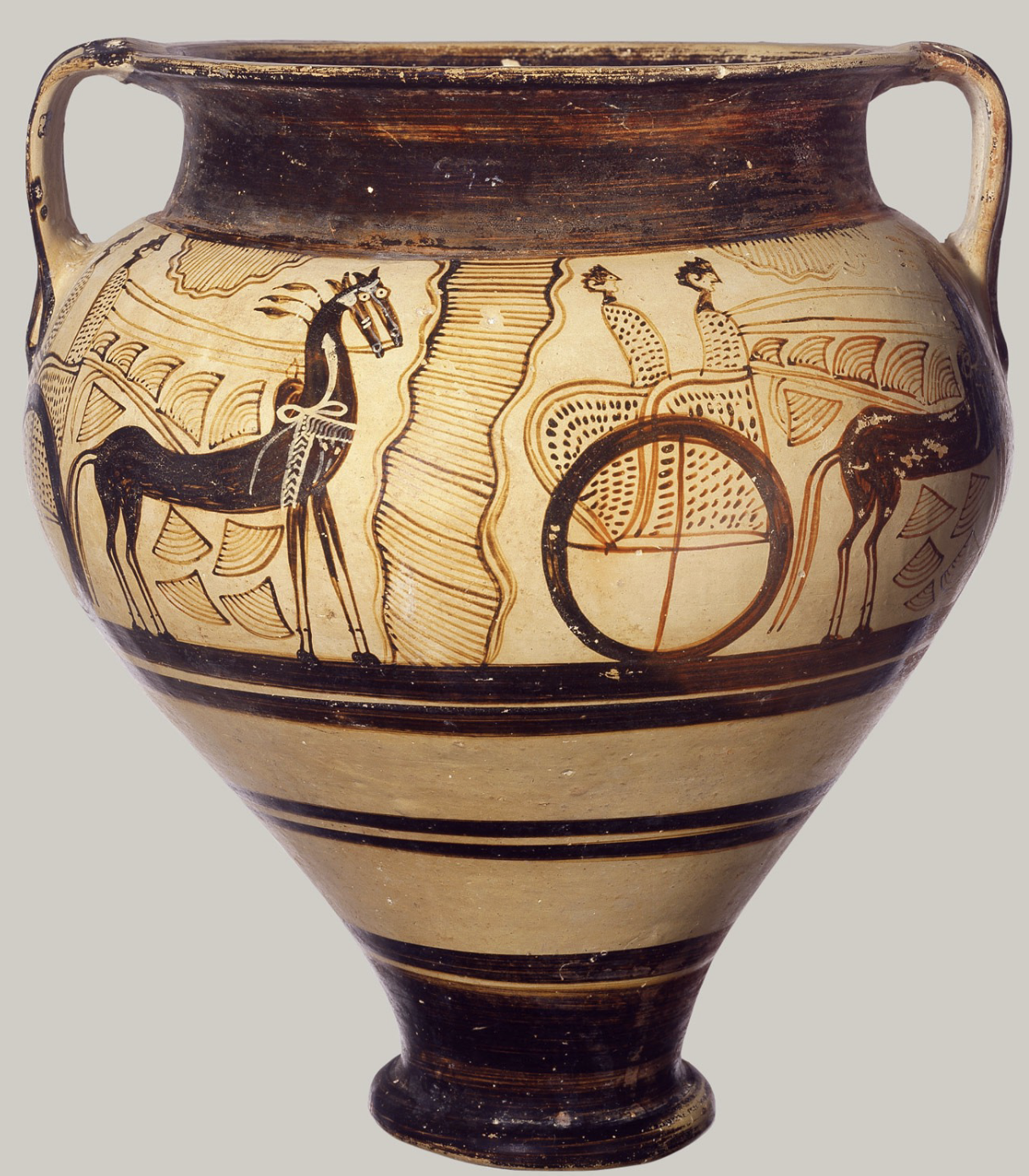
also LH 3
Pictorial style again
Mycenaean krater

protogeometric pottery
11th-10th cent. BCE
in Athena first…Keirameikos cemetery which was a little outside the city
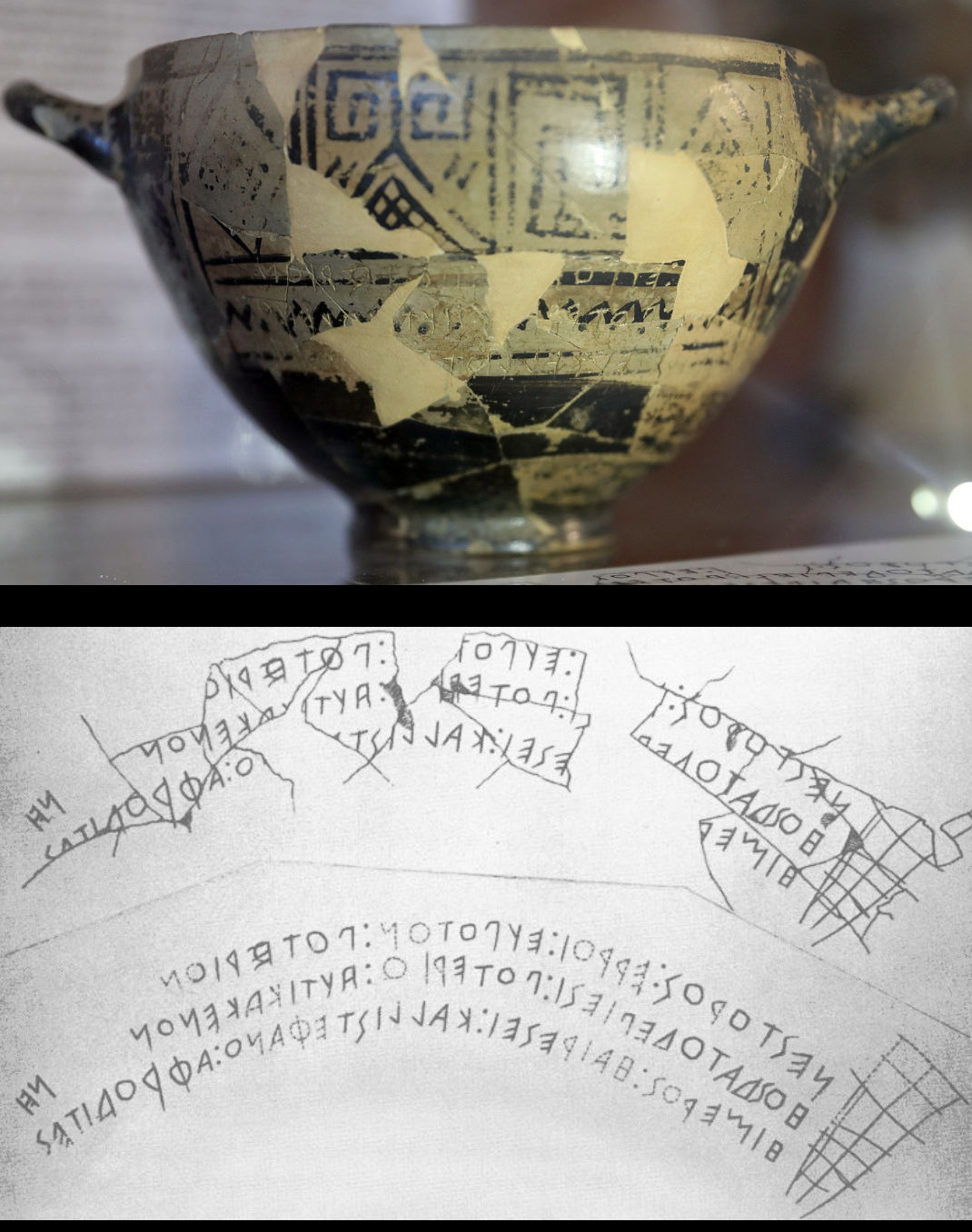
Cup of Nestor!
8th cent. BCE
from Pithekoussai (Ischia)
inscription stuff: “I am the cup of Nestor good for drinking…” so cunty!
If you drink from this cup you’ll feel flirty!
this cup has agency and you can interact with it!
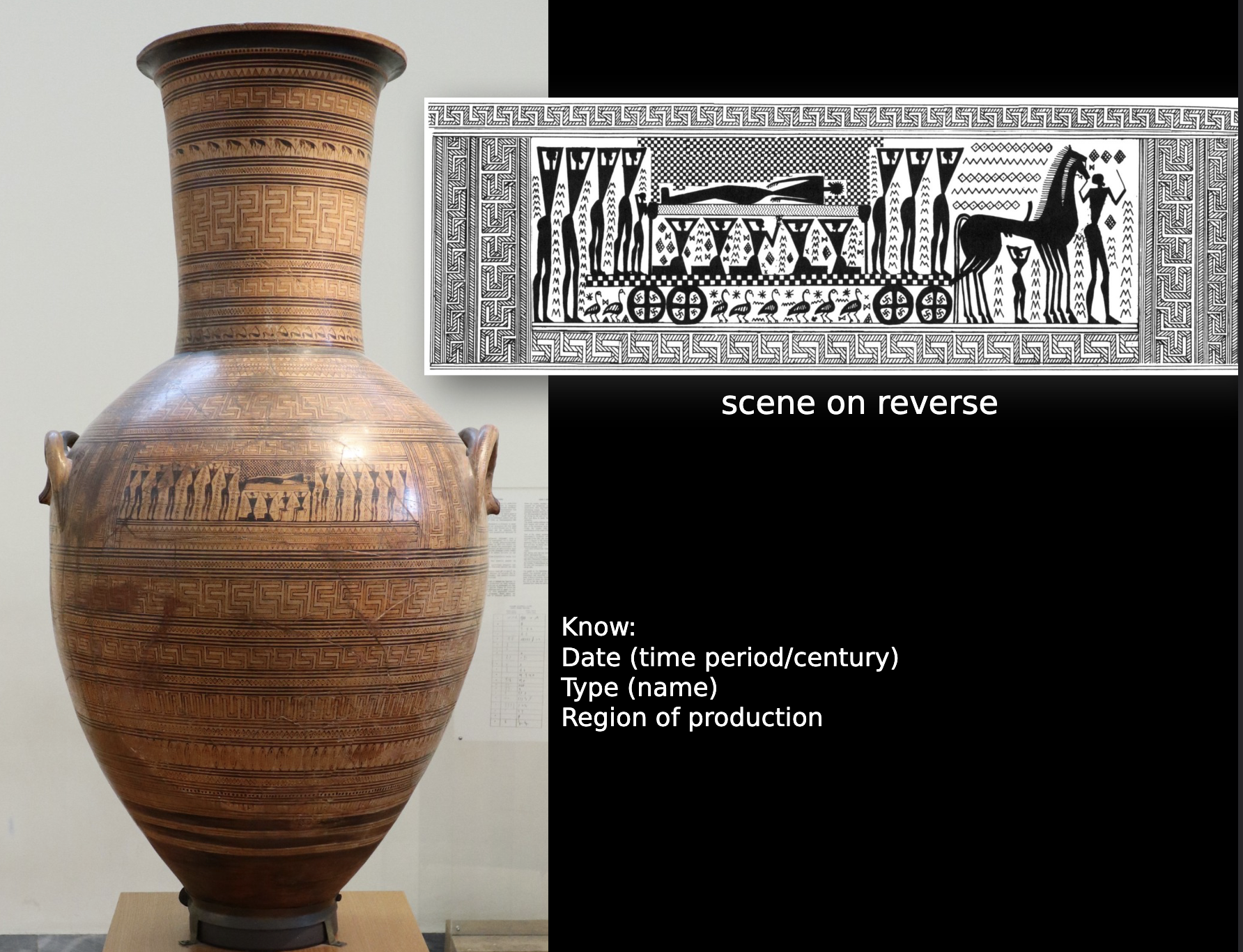
dipylon pottery (this is a trendsetter lowk first of its kind like others like it called dipylon pottery bc of this one
also keirameikos cemetery in Athens
730 BCE
5ft tall, burial vessel that shows funeral scenes
the specific scene on this= the prothesis scene
this = ceremonial display of the body, mourners are showed bc of hands on head
the black and white scene on this=the ekphora scene
this= ceremonial procession to cemetery with mourners
horror vacui= fear of empty space! aah! eek!
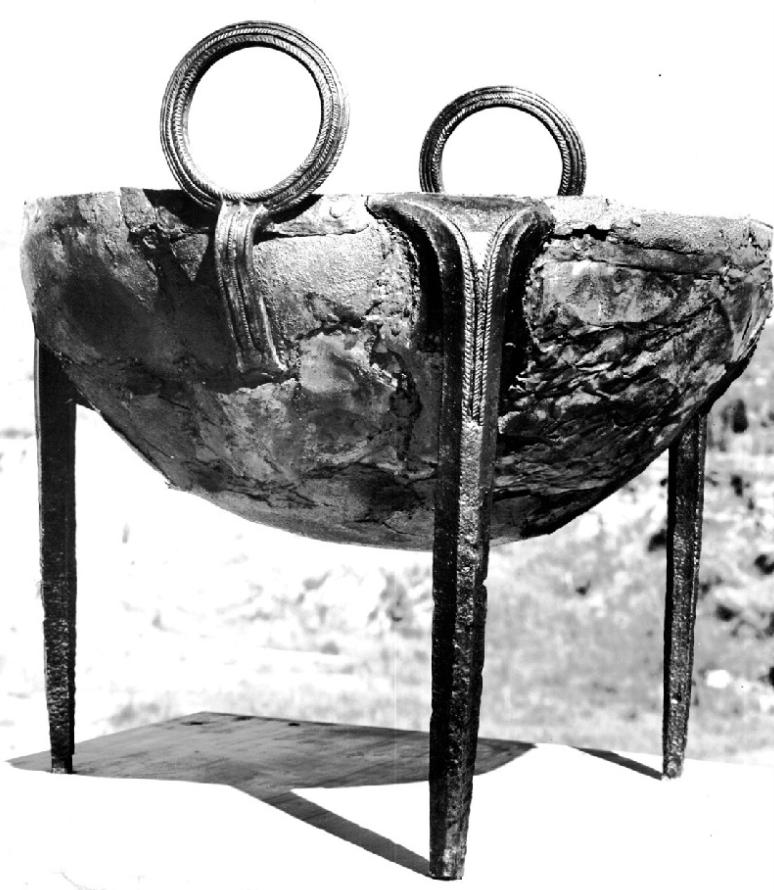
bronze tripod cauldron
8th cent. BCE
attached legs and ring handles= mainland greece
from olympia: this is where the first olympic games were in 776 BCE… perchance at least
place of zeus
Pelopeion at Olympia!
local myth king Pelops like races Oenomaeus for Hippodamia and beats him by replacing other guys’ axles with beeswax
pelopeion itself is empty tomb where pelops was said to have been buried
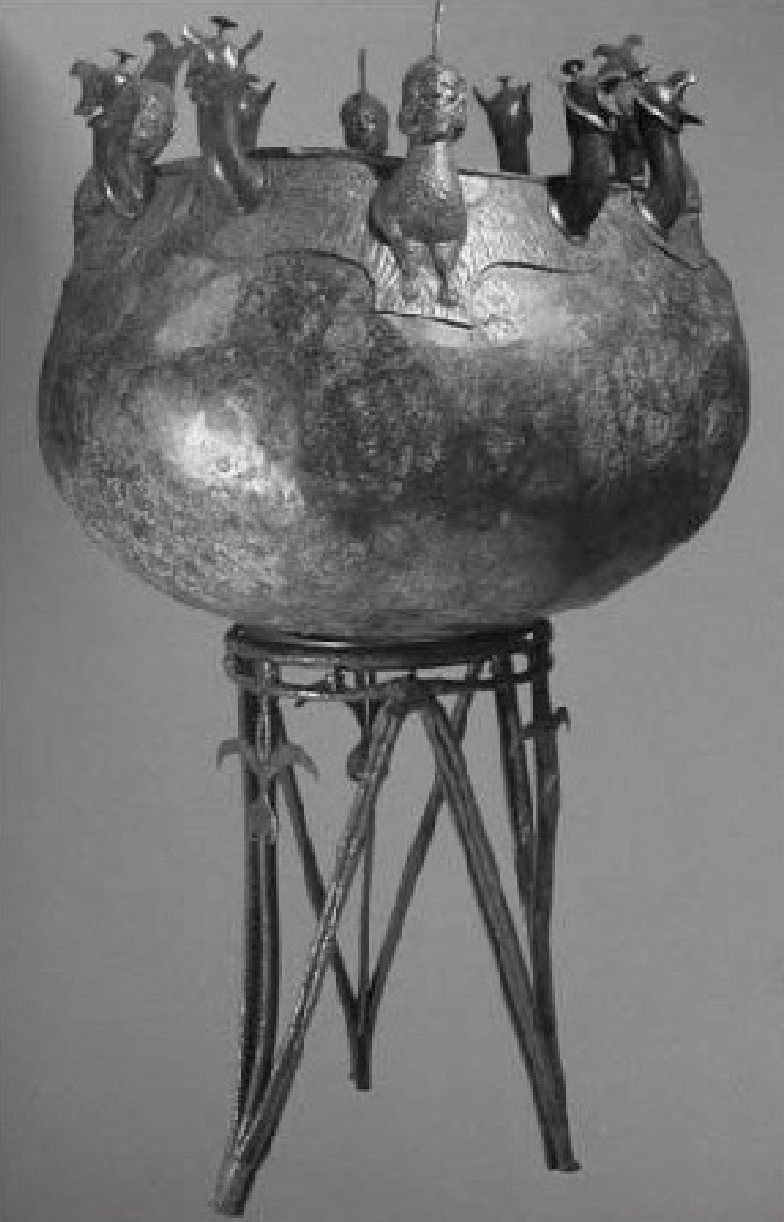
bronze cauldron with griffn heads
8th cent. BCE
Cyprus
display of great wealth but by mid 7th cent just moderate wealth
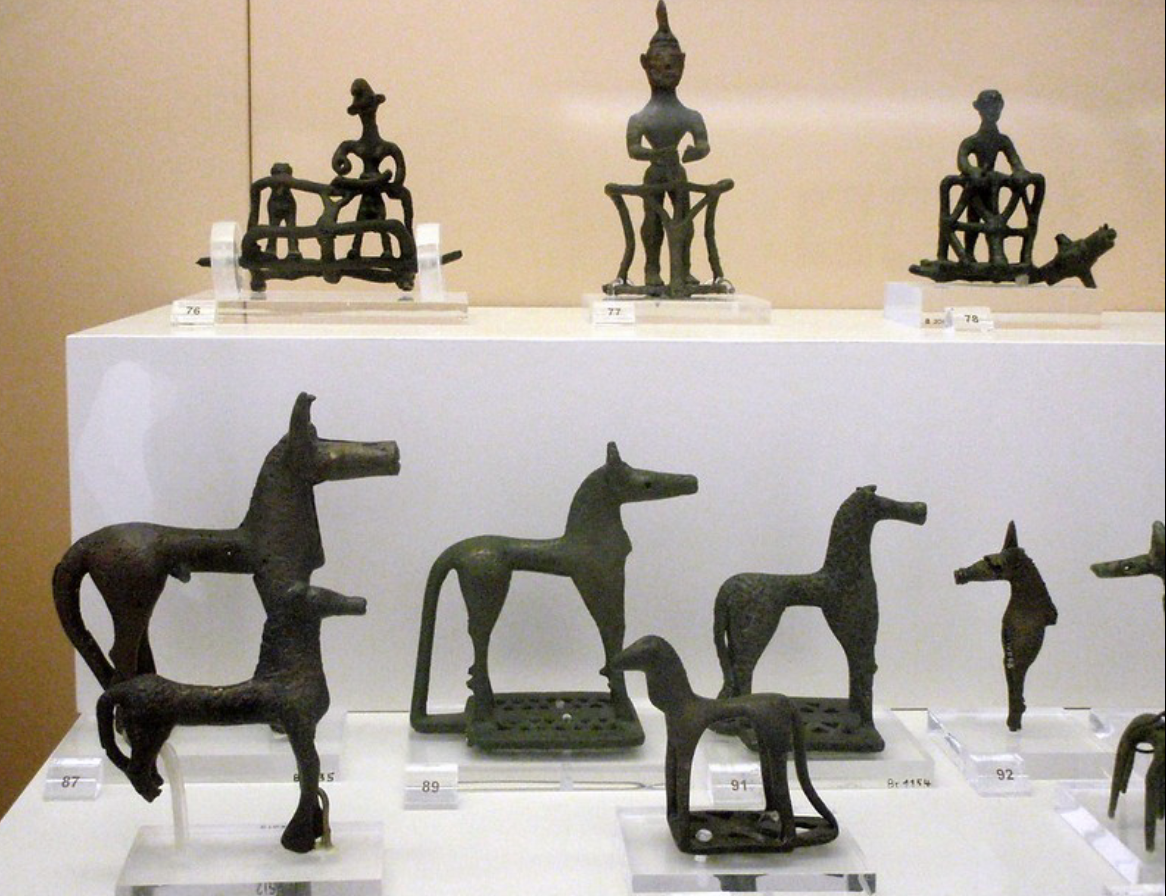
bronze votives
8th cent. BCE
charioteers and horses
from olympia
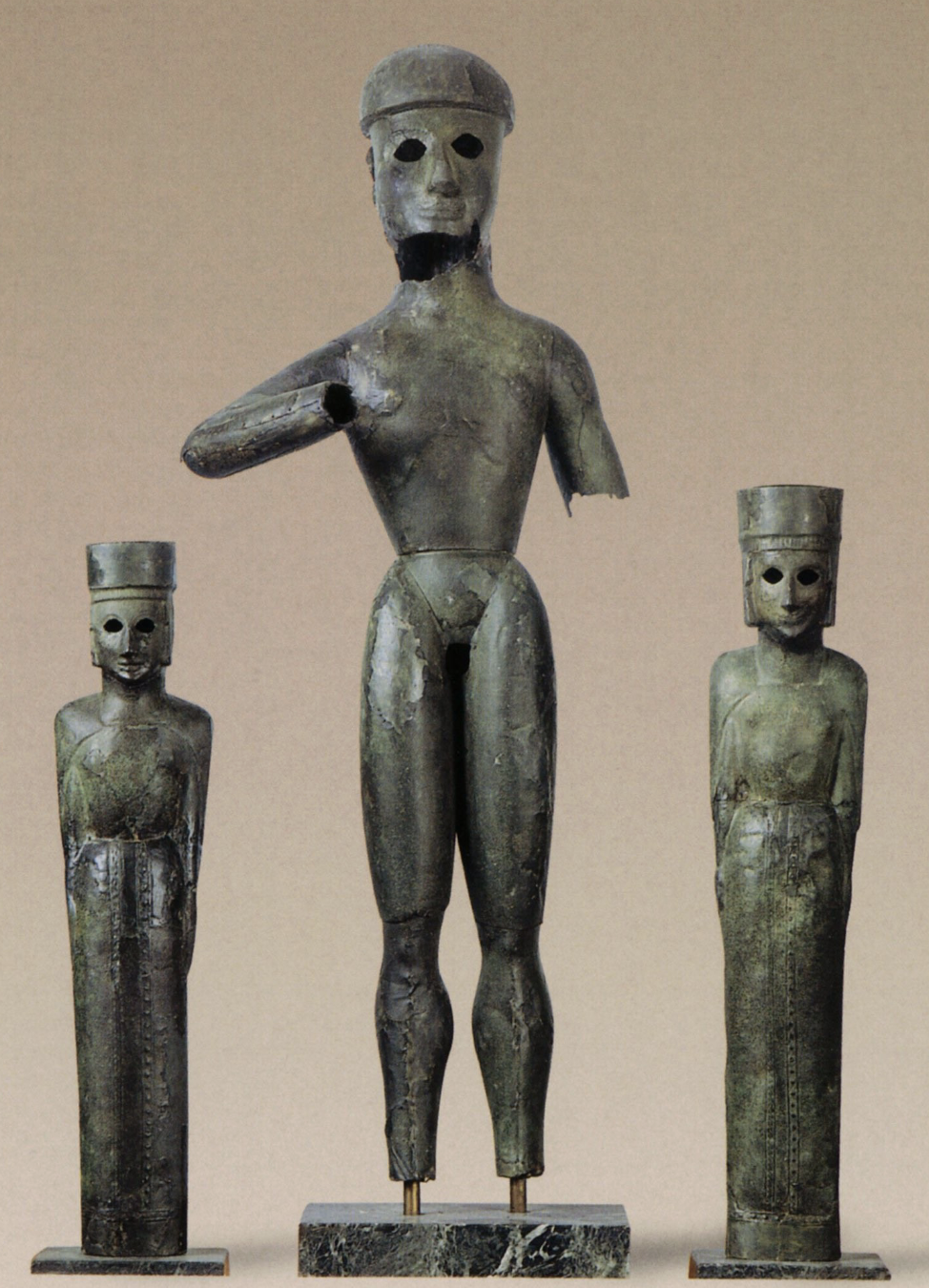
bronze hammered statue (over wood)
apollo is probs the large figure while the smaller ones are artmeis and leto
these were cult statues so they were in temple
they’re from Crete
7th cent. BCE
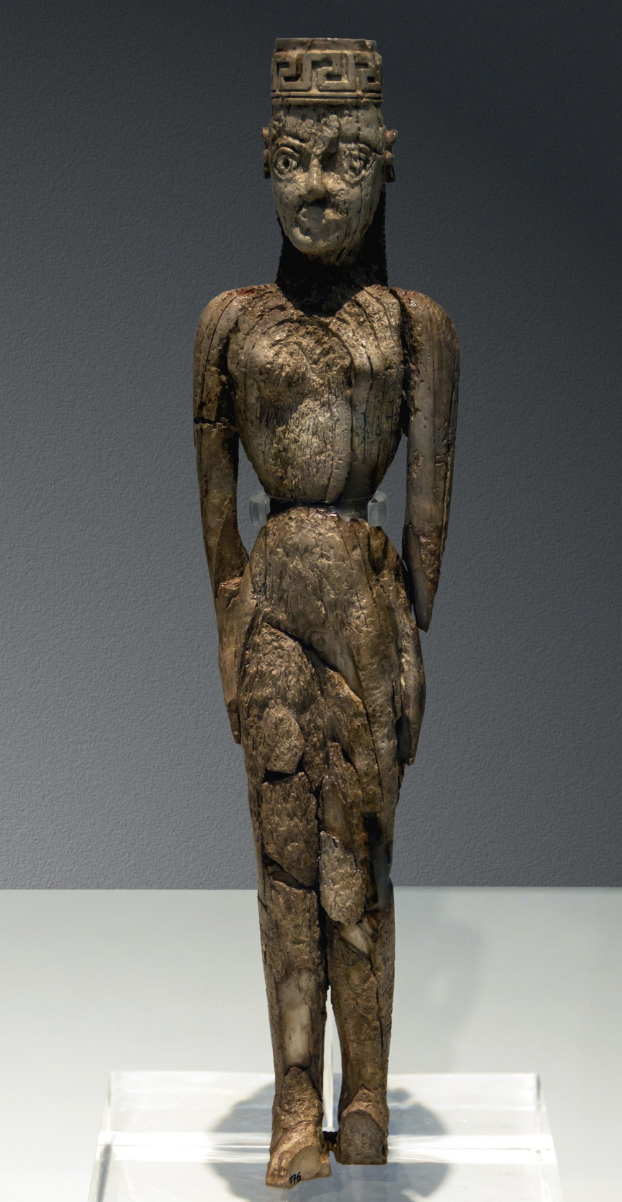
ivory figurine
8th cent. BCE
ivory was sourced from trade connections in near east
the female nudity in this is Near East influence
her headress= polos and it has geometric influence
her triangular proportions are also v geometric
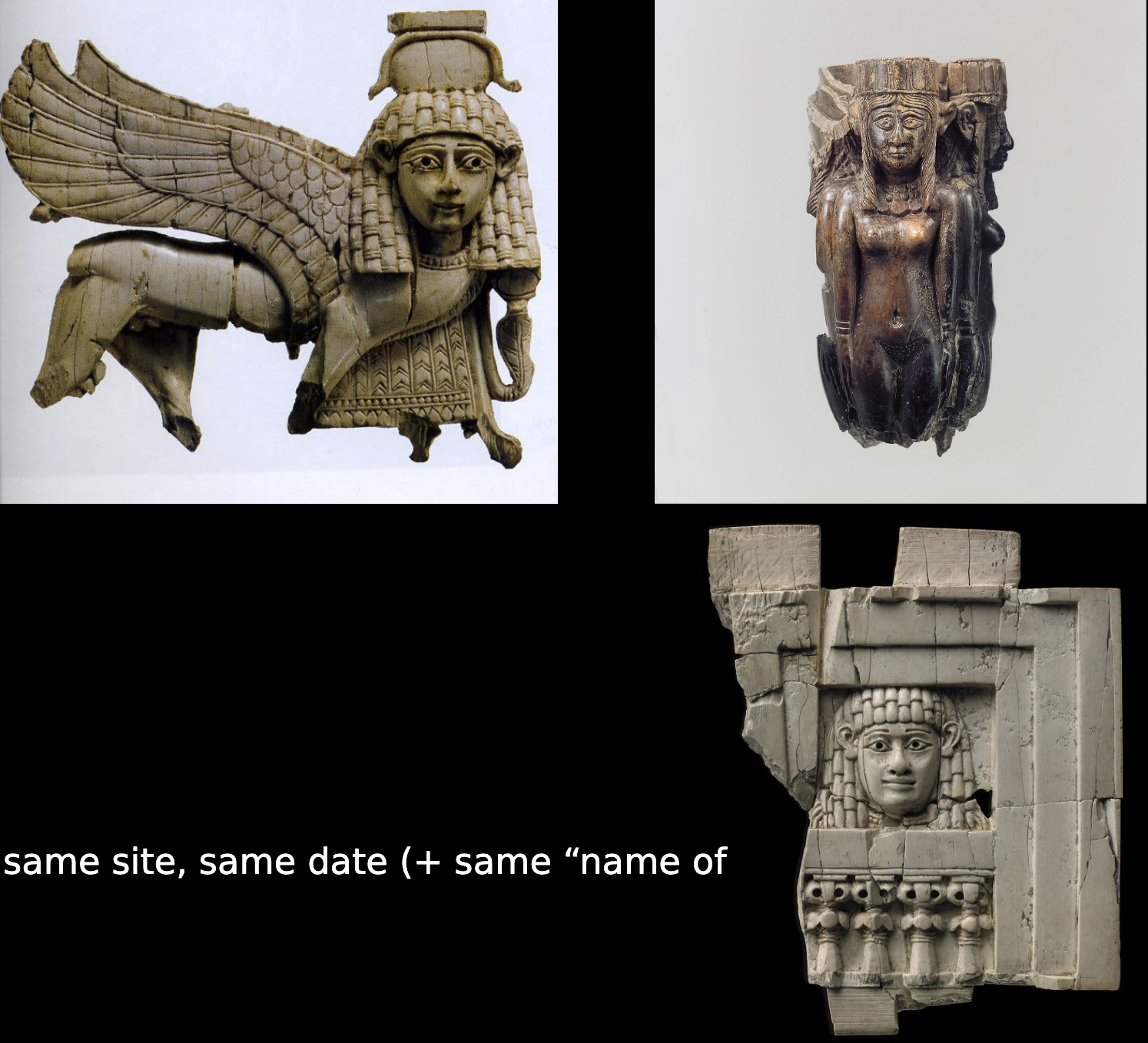
Daedalic style
nimrud ivories
9th-7th cent. BCE
syro-phoenicean ivory carving
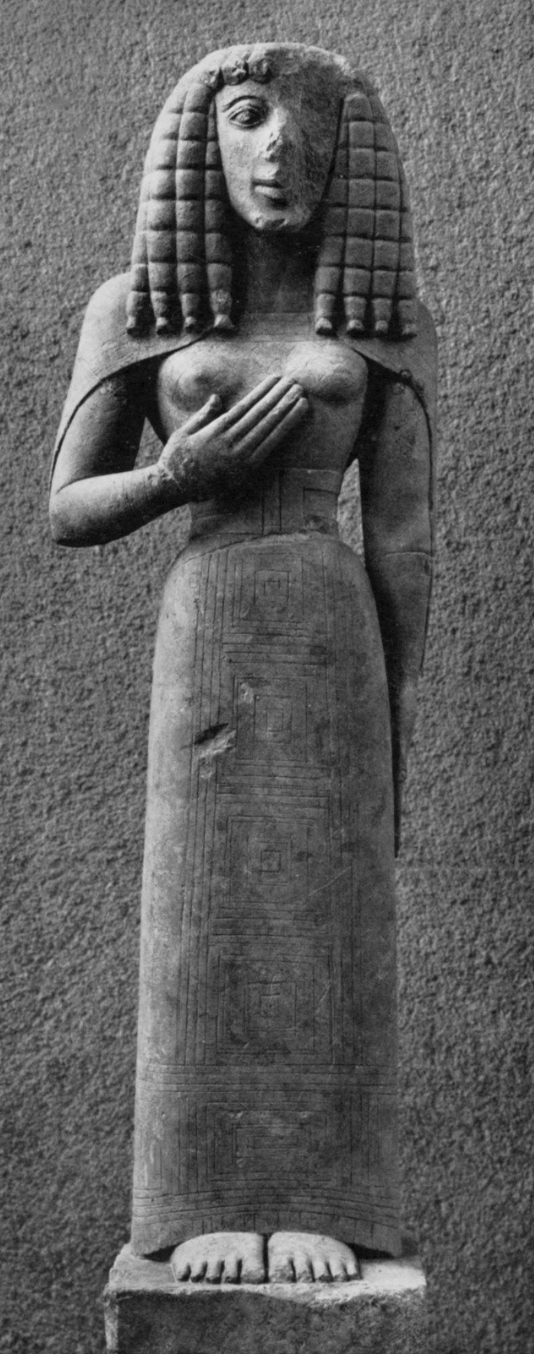
Lady of Auxerre
640 BCE
Crete
daedalic style (which originated in Crete)
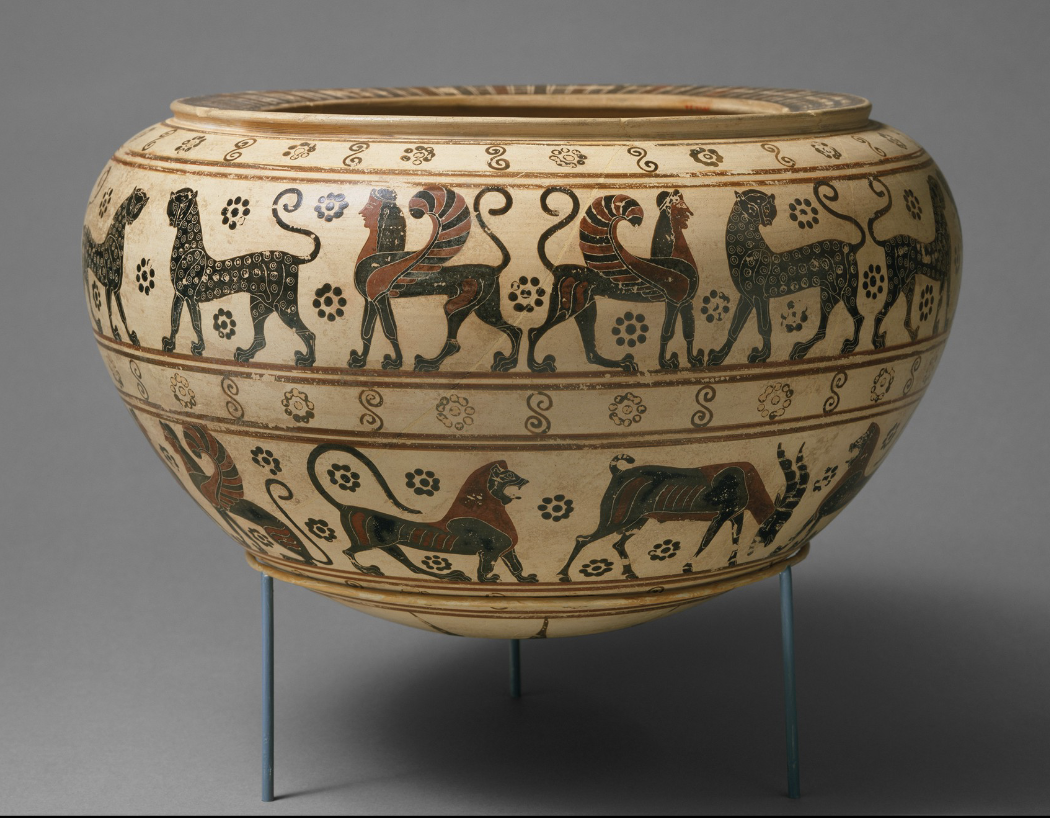
Protocorinthian pottery
7th cent BCE
dinos (mixing wine with water)
from corinth
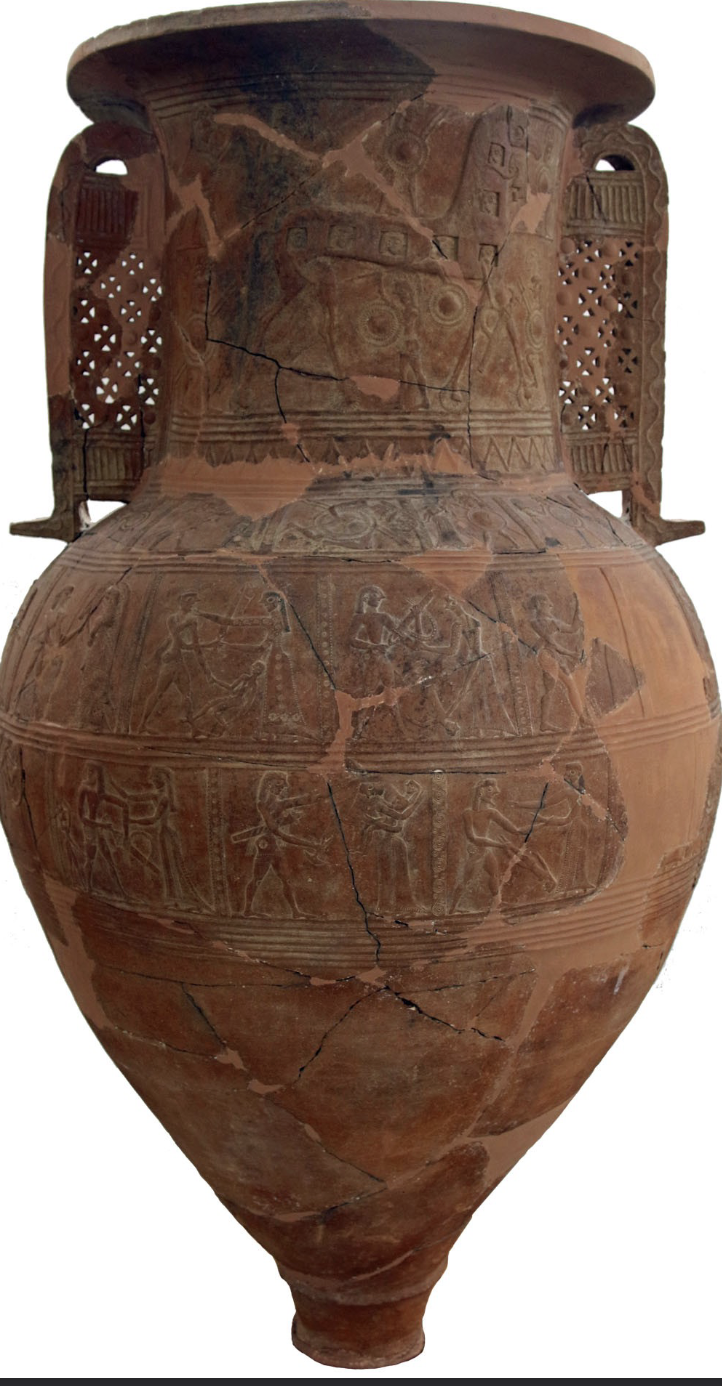
mykonos amphora: 650 BCE
relief pithoi
mythological scenes!
cyclades and N. Aegean

eleusis amphora: 650 BCE
protoattic pottery
also mythological scenes!
there are freaky woman gorgons decorating it

temple of hera at Samos
hekatompedon 1(100 footer)
8th cent.
mudbrick and with central columns
apsidal and with benches
the earliest roofs were thatched
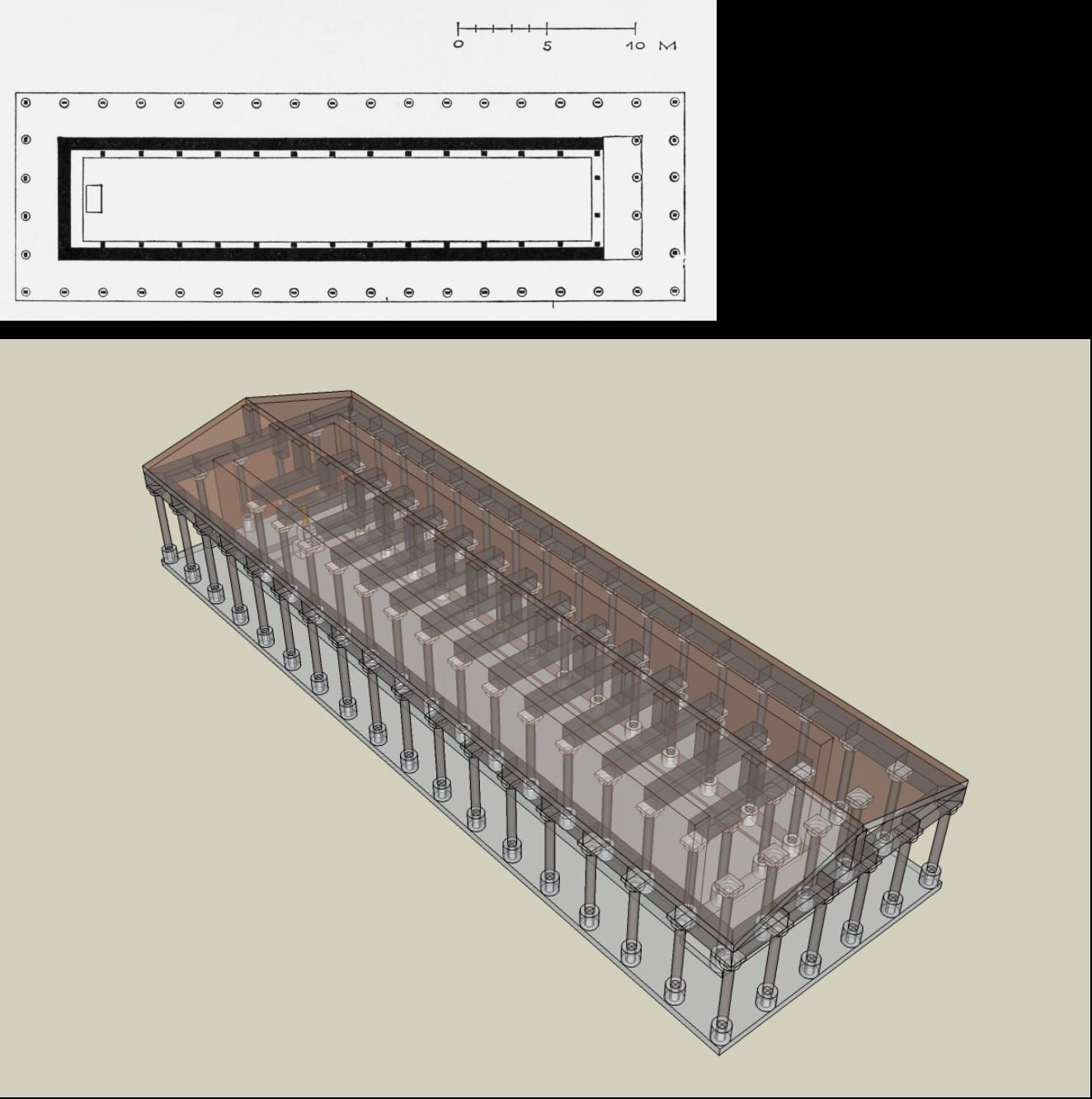
hekatompedon 2
we’re getting fancier with limestone and two rows of interior columns
650 BCE
may be peripteral? (porches and columns surrounding)
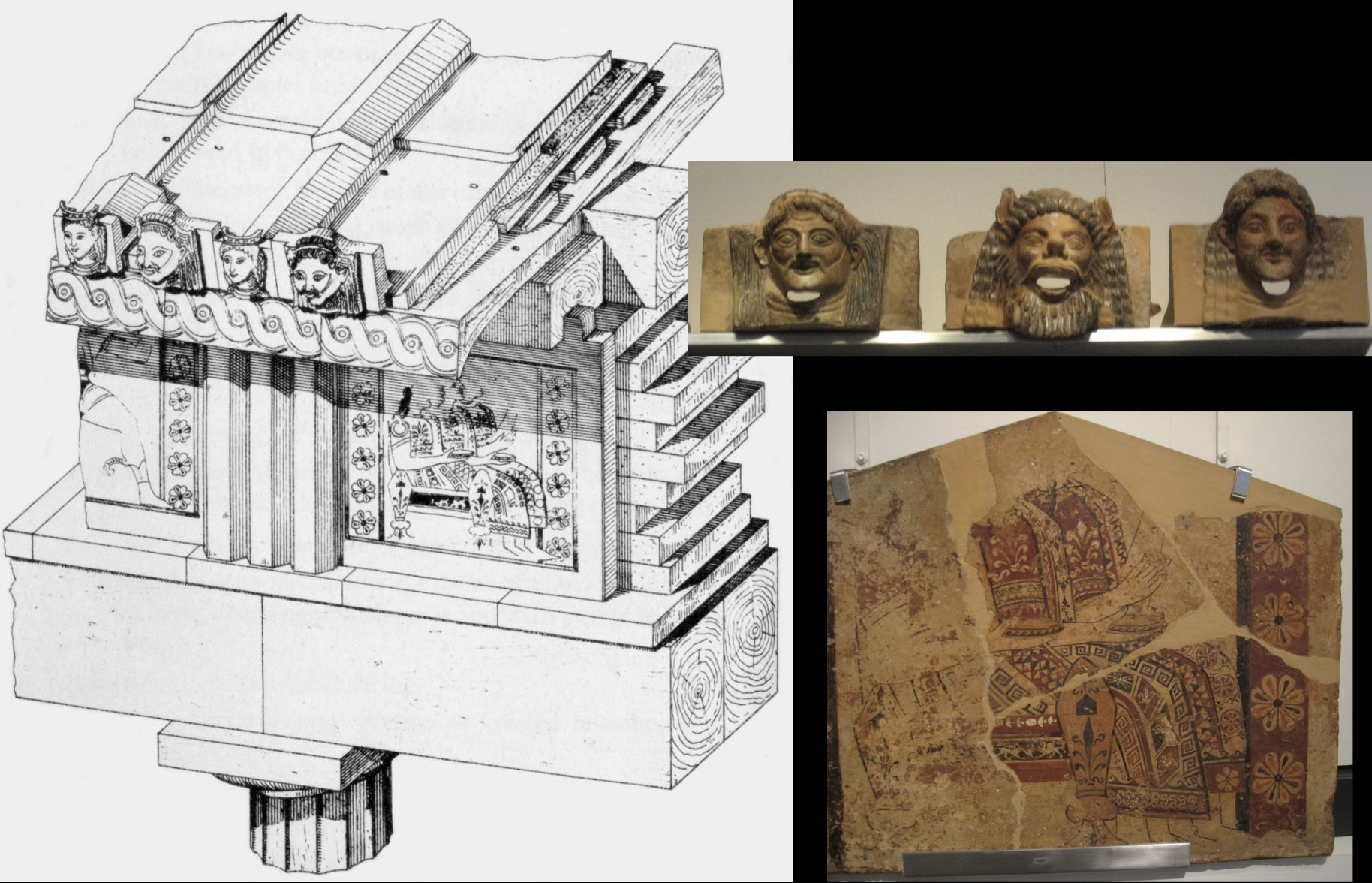
entablature at the temple of apollo in thermon
there are wooden elements and terracotta/clay elements such as the metopes and antefixes
tile roof
7th cent.

temple of artemis at corfu!
this is on a doric archaic temple
its a pedimental sculpture in limestone: central figure=gorgon
and zeus is attaching a giant in the corner?
there are also heraldic felines
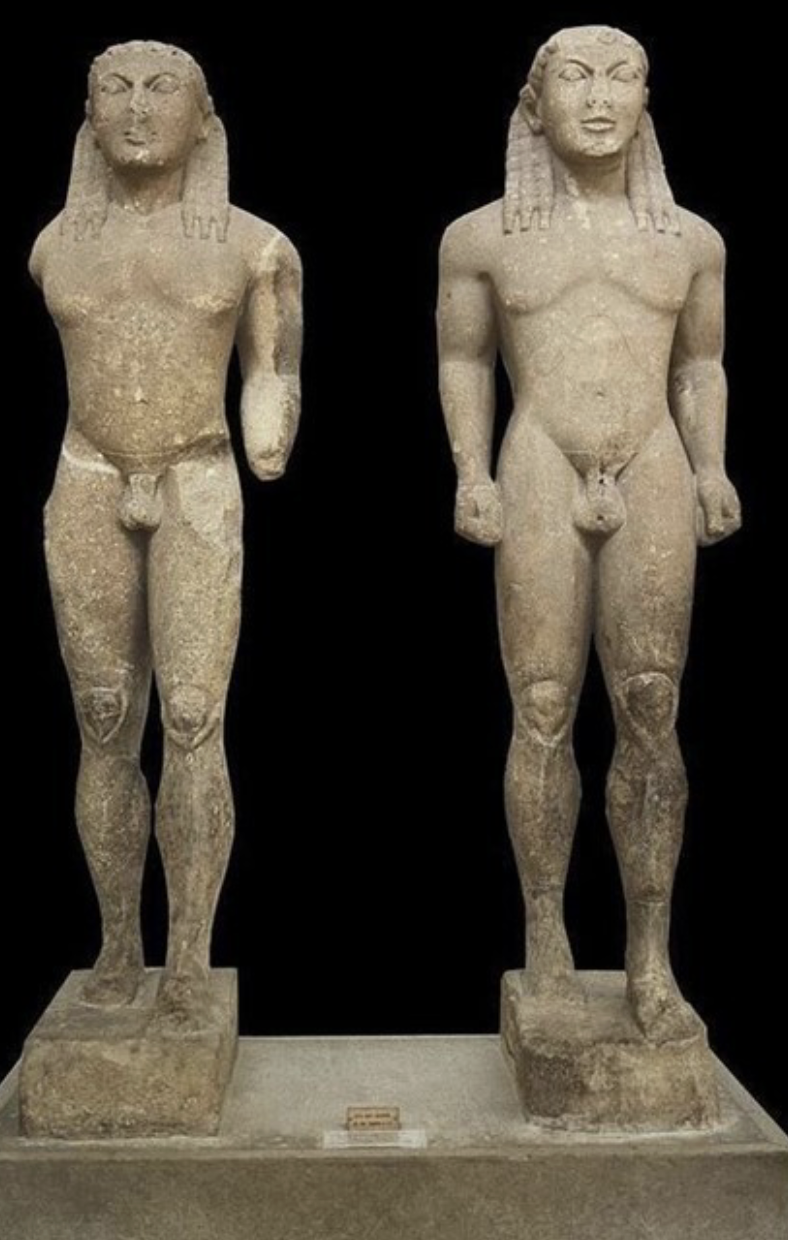
twin kouroi
580 BCE
inscription says sculptor from argos
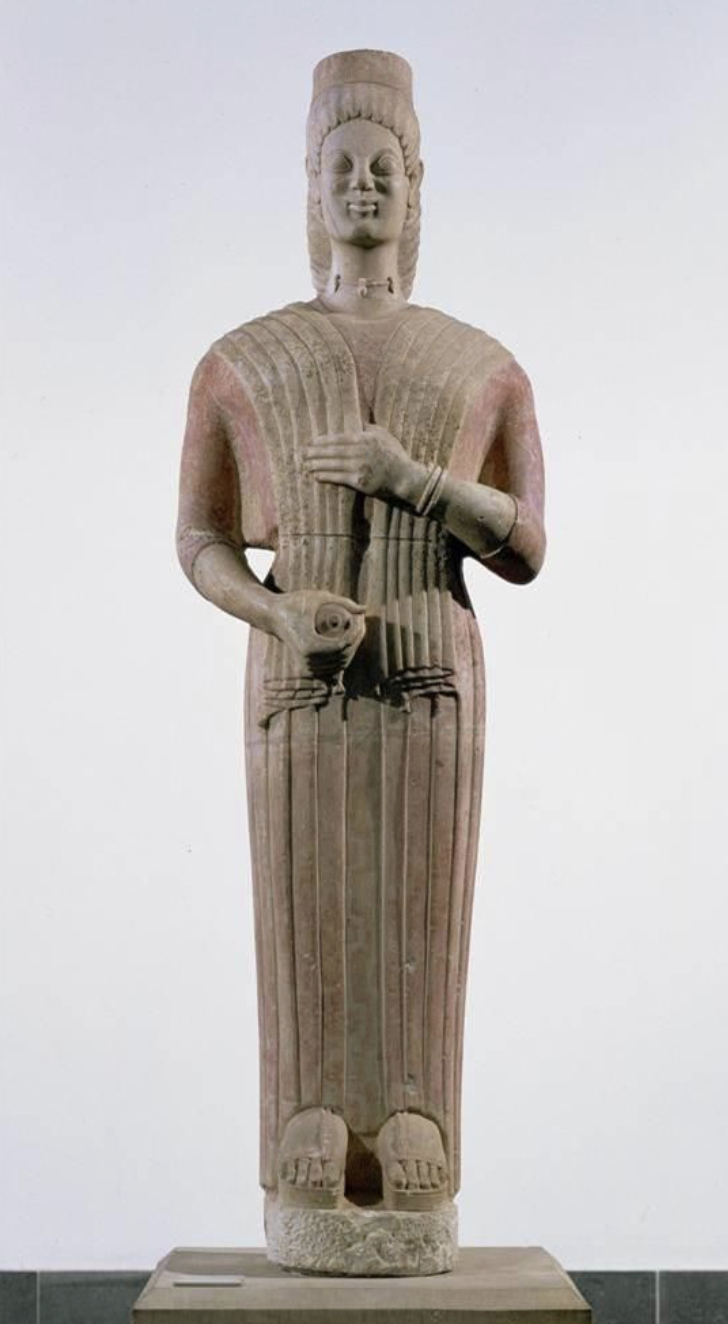
berlin kore
archaic smile
570 BCE
attica
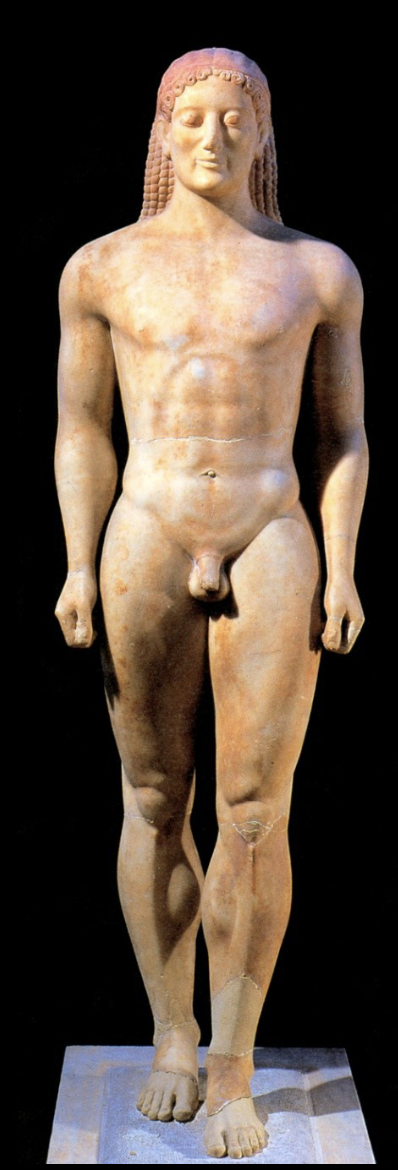
Anavysos kouros
530 BCE
attica
we’re becoming more realistic and 3d with our sculptures!

Phrasikleia!
she’s such a baddie
look at the movement in her skirt with her pulling it out
we’ve still got archaic smile
540 BCE Attica
“I shall be forever called kore, allotted this name from the gods in place of marriage” so she was a real girl who died before marriage
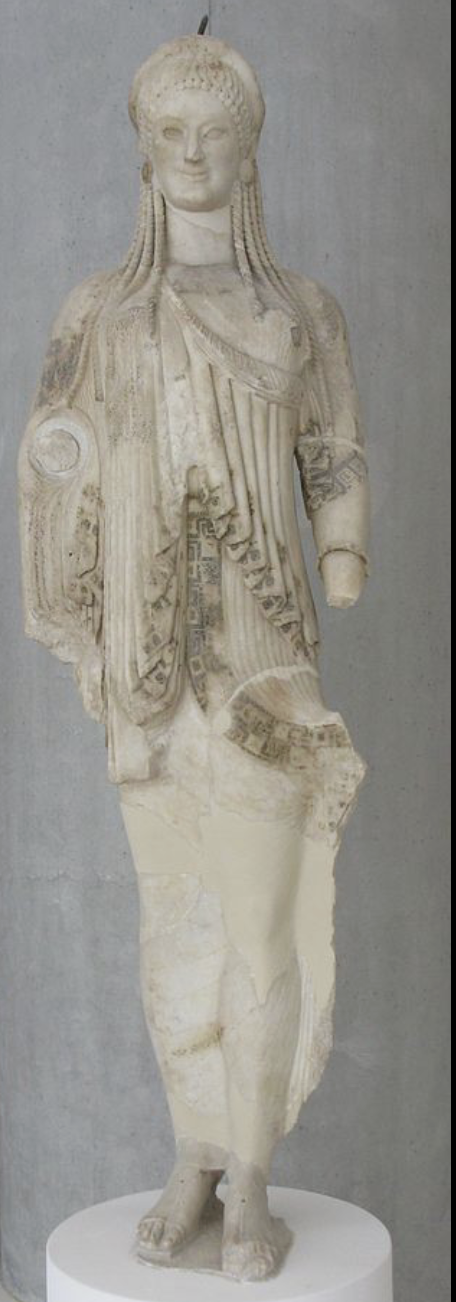
“kore 682”
520 Attica
she’s wearing chiton and himation
still have archaic smile
but a lot more drapery and we can see that she has legs and limbs and such under her clothes so more realistic
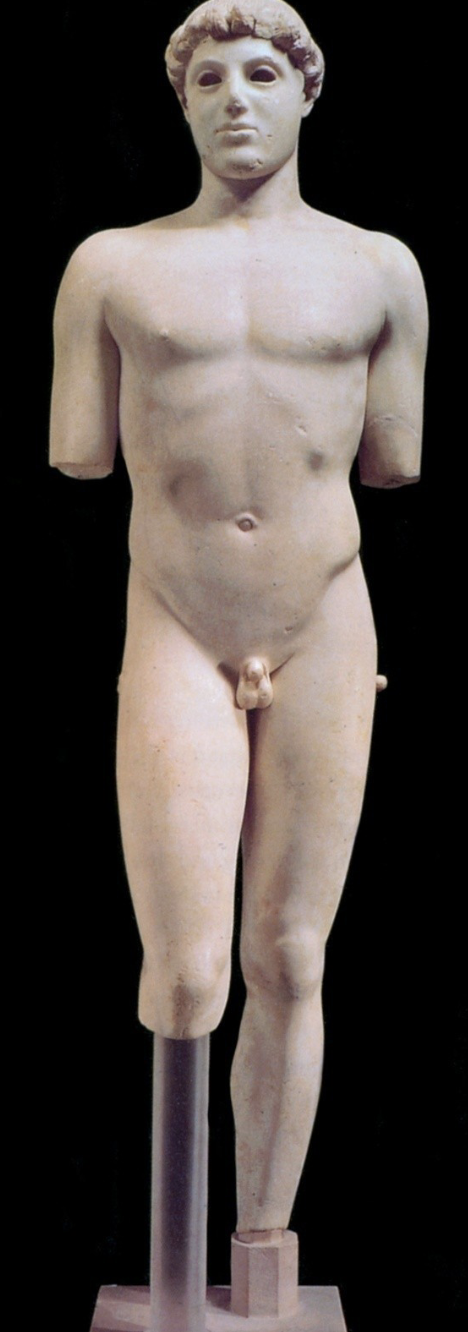
kritios boy!
“no longer a type, but a subject”
so this is a kouros by Kritios
475 BCE
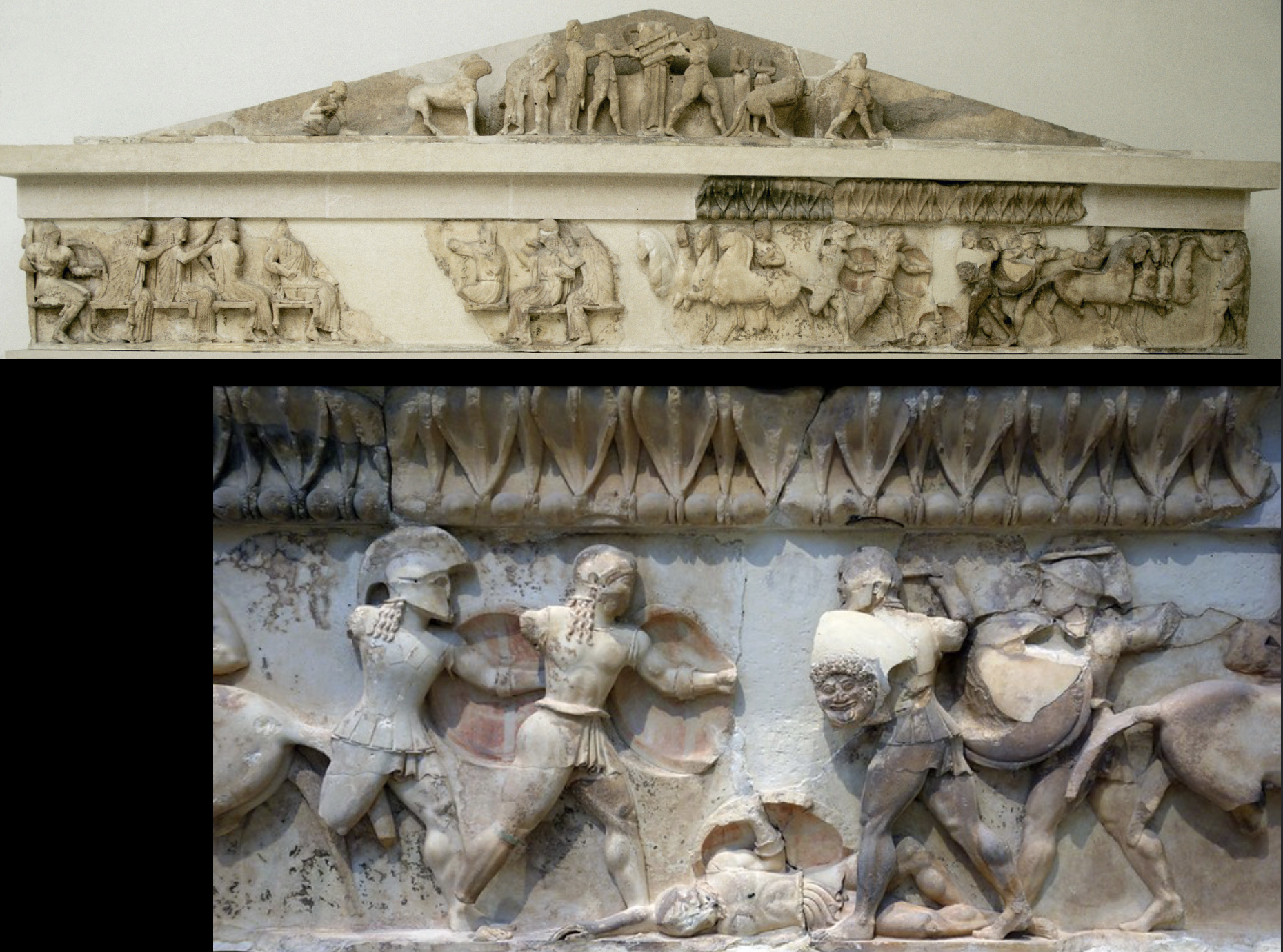
from the siphinian treasury
shows well known scenes
east frieze combat at troy
500s BCE
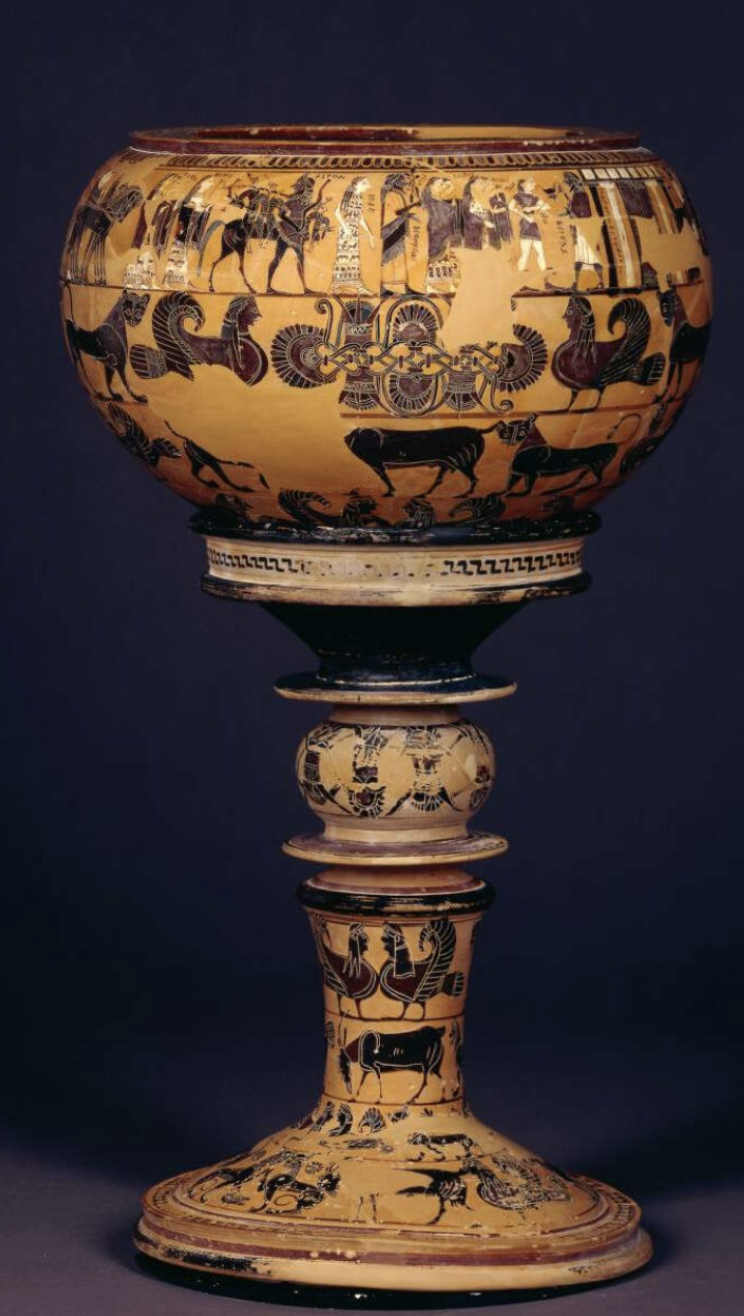
black figure dinos with stand
created by Sophilos!
590-570 BCE
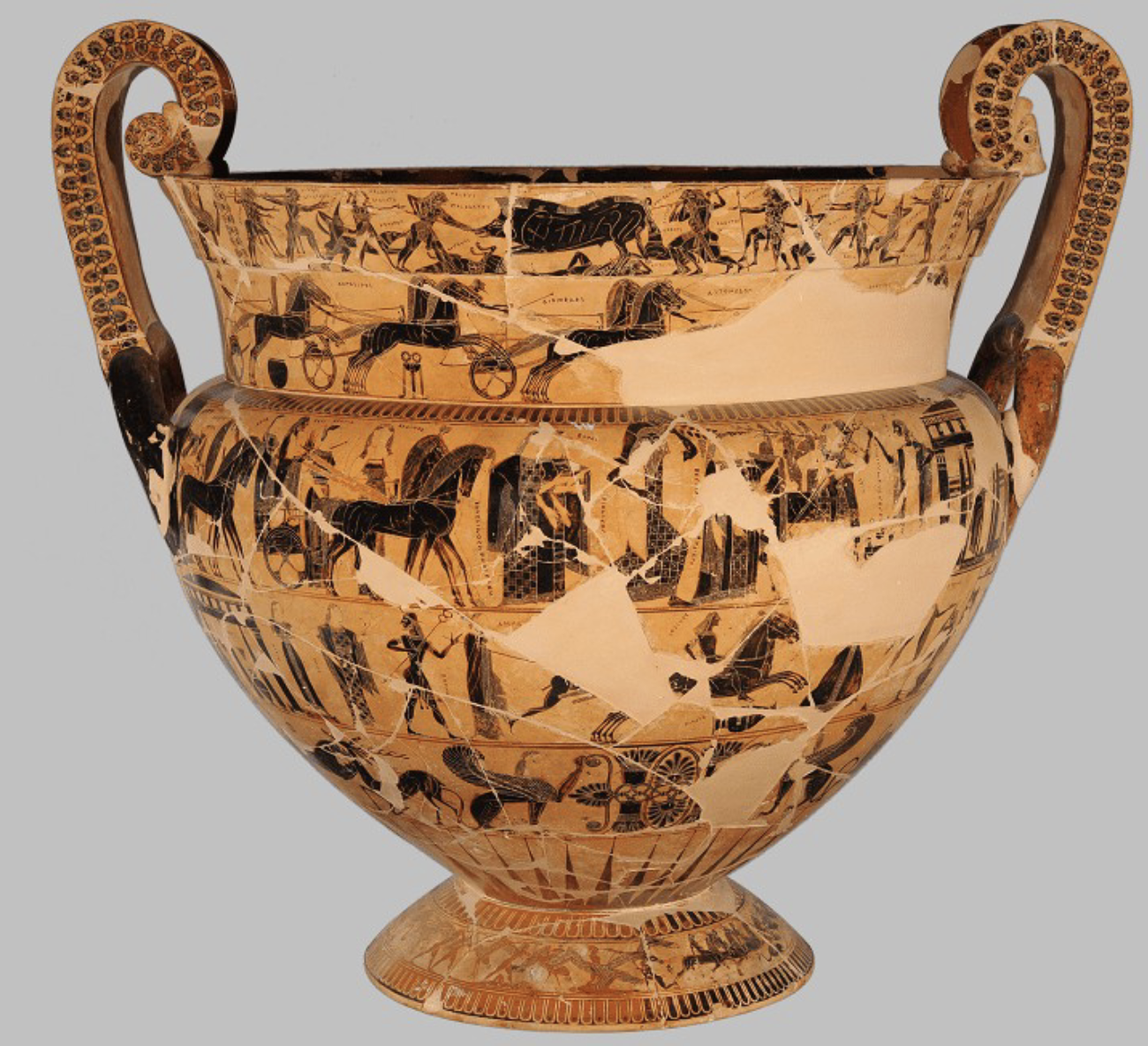
Francois vase!
560 BCE
black-figure volute krater
Kleitas= painter while Ergotimos=potter
there are all these layers of scenes from top to bottom:
1. Calydonian boar hunt
2. funeral games for patroklos and lapiths vs. centaurs
3. wedding of peleus and thetis
4. achilles ambushes troilus and hephestaus returns to olympos
5. pygmies vs. cranes
this is another example of the pot speaking for itself!
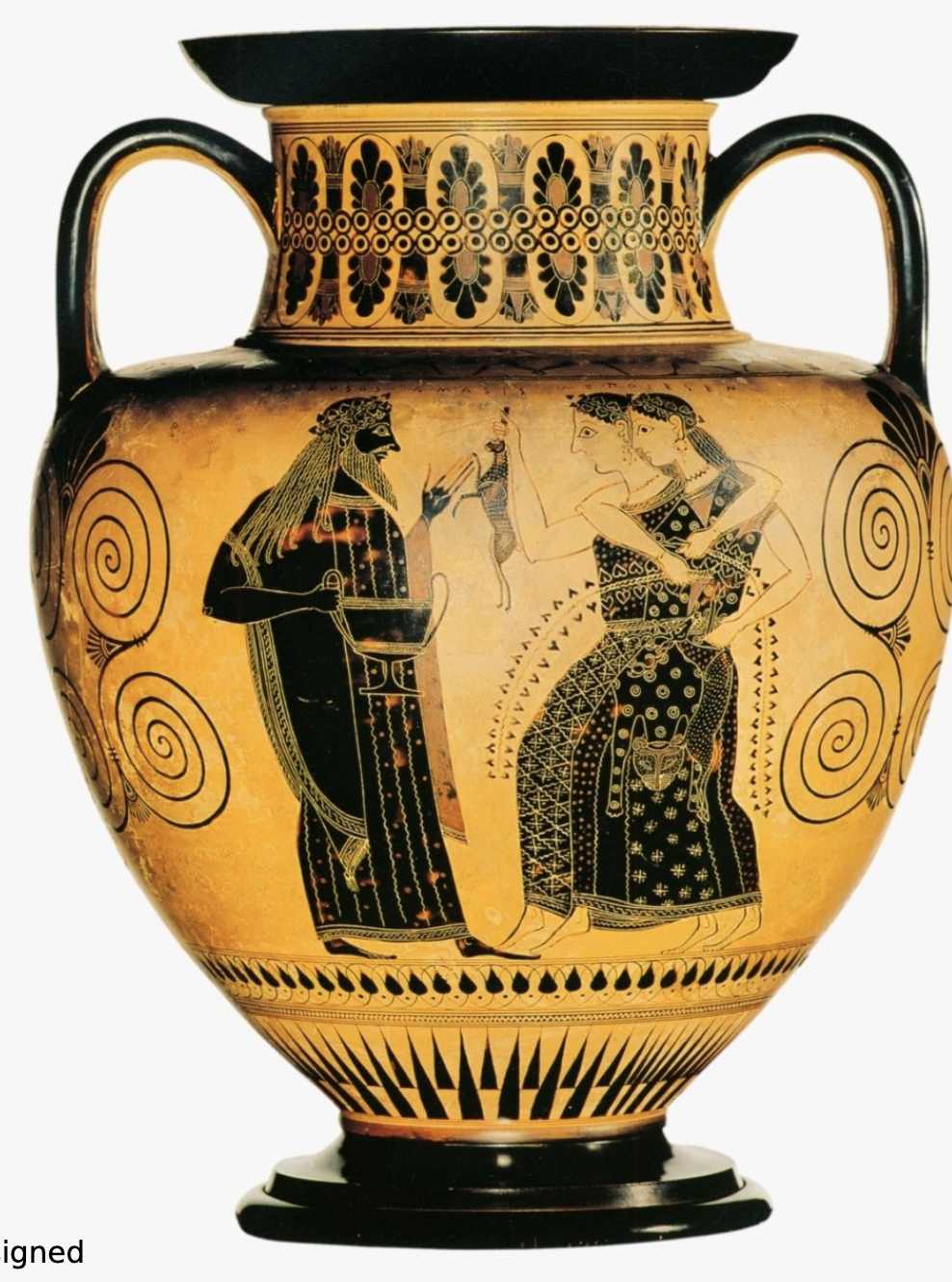
from Amasis painter!
mid 6th cent. BCE
dionysos and maenads
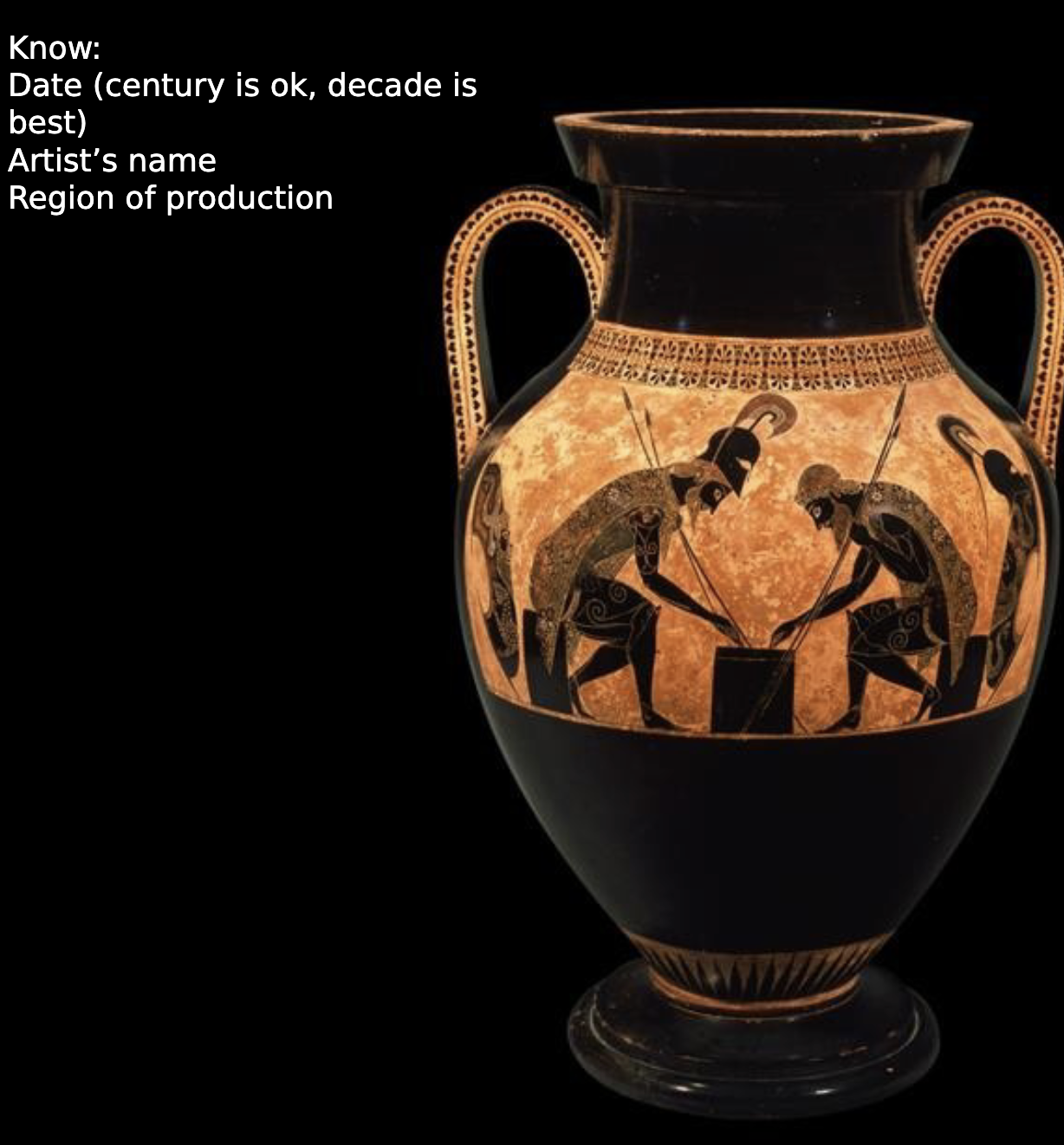
from exekias!
he worked from 545-530 BCE
liked specific scenes from myth and psych and inner thoughts
this vase specifically shows achilles and ajax playing game

Reveller’s vase
this one is from Euthymides
he’s part of the pioneer group
pioneer group=515-500 BCE
they were #frenemies
twisting forms, dynamic movement,
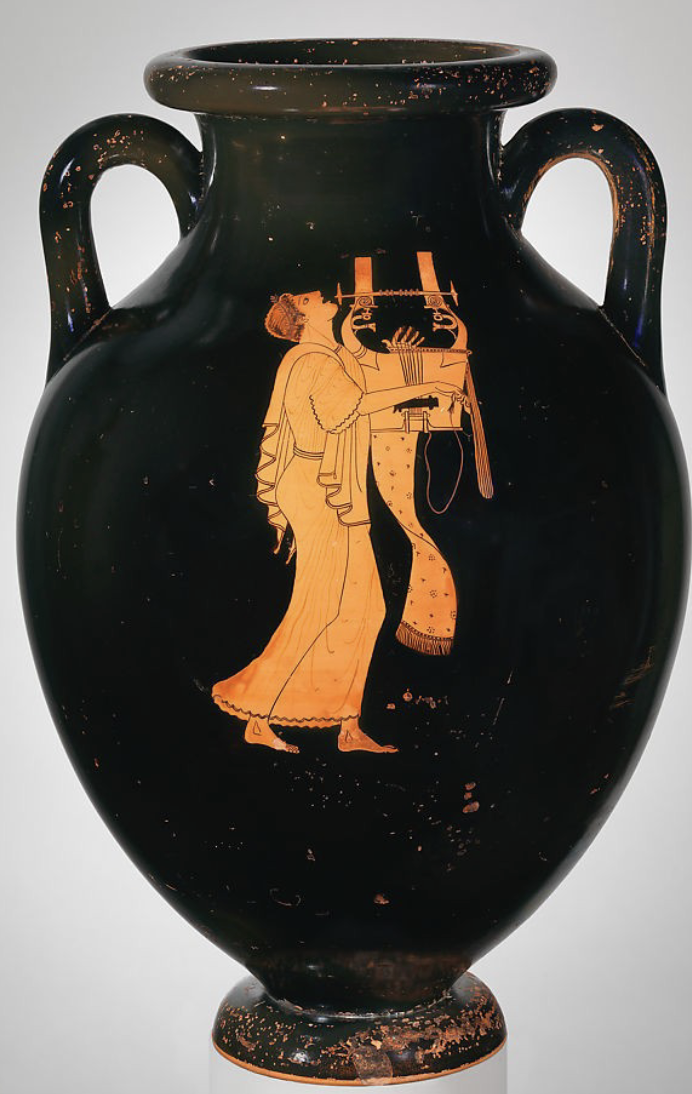
Berlin painter!
490s-460s BCE
all work is unsigned!
tropes of minimalism and solo figures but may have trained with or studied pioneer group

another berlin painter one!
you can tell that this is a Greek fighting a non-Greek because Greeks would never dare to wear pants or fur!
and this shows Greek defeating non-Greek which is perfect for boosting Greek peoples’ egos!
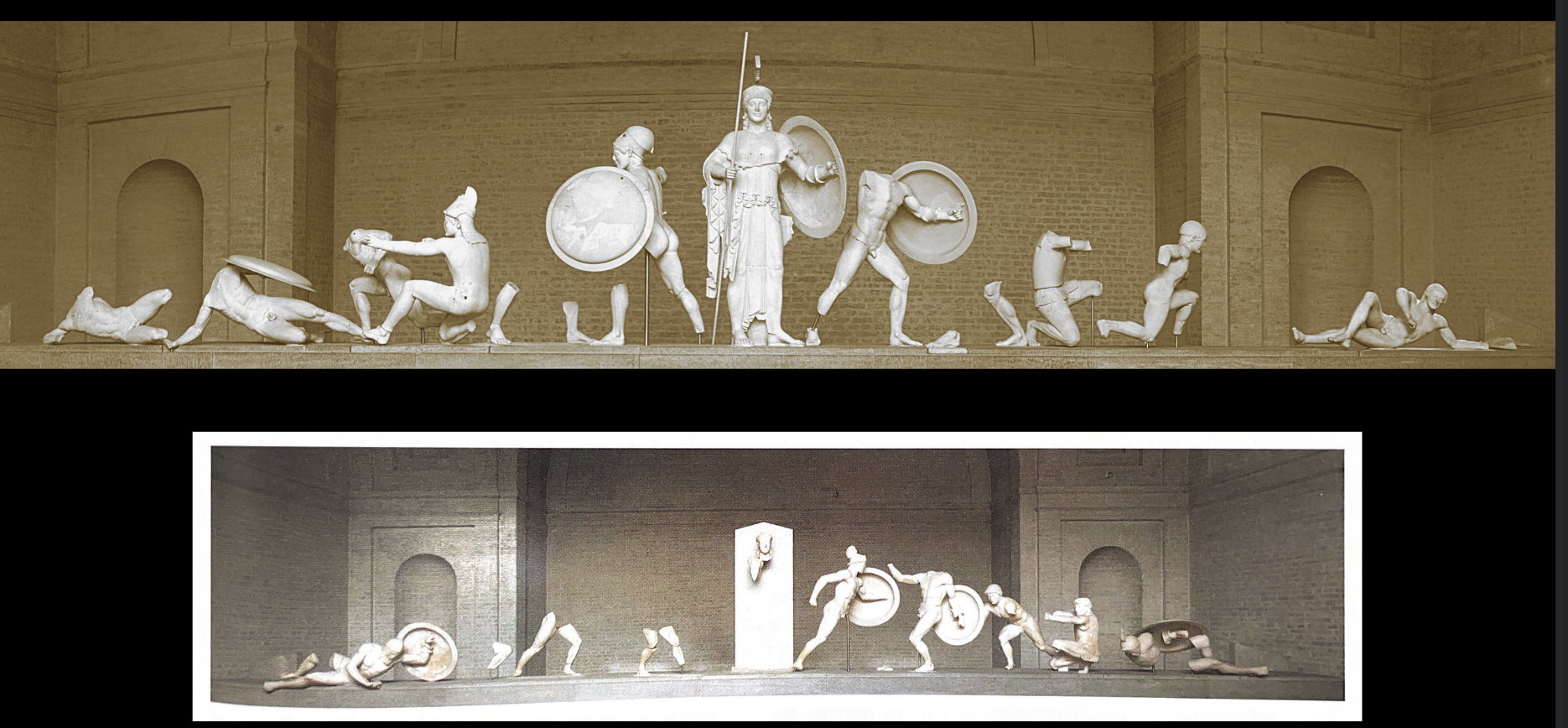
temple of aphaia, Aegina
470s BCE
the west pediment=very stilted and posed
whereas the east pediment is more realistic and dynamic like the movement looks more natural
look specifically at the men on the ends on the ground!!!
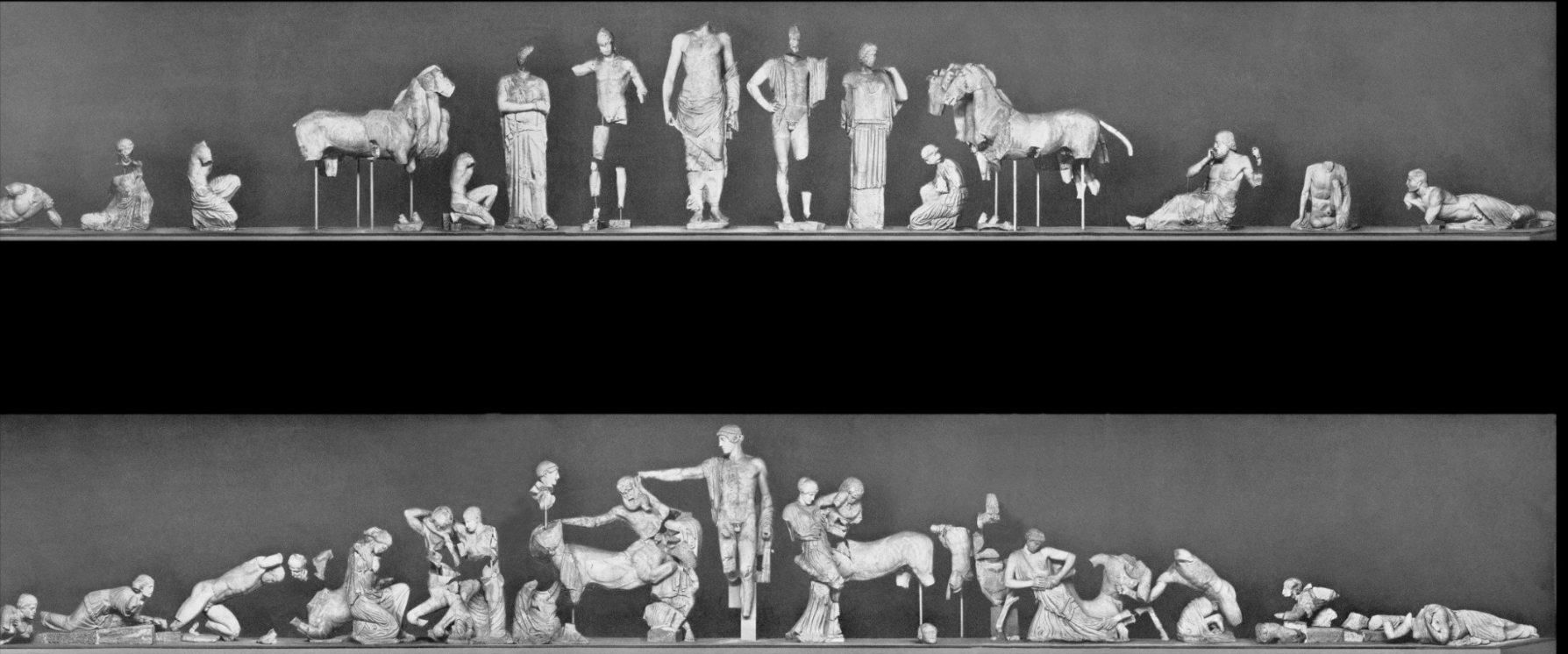
temple of zeus, olympia
470-450 BCE
east pediment=pelops vs. oenomaos in chariot race
east pediment has doughy drapery! chunky
this doughy drapery called severe style
west pediment=battle of lapiths and centaurs
west pediment also has chunky drapery!
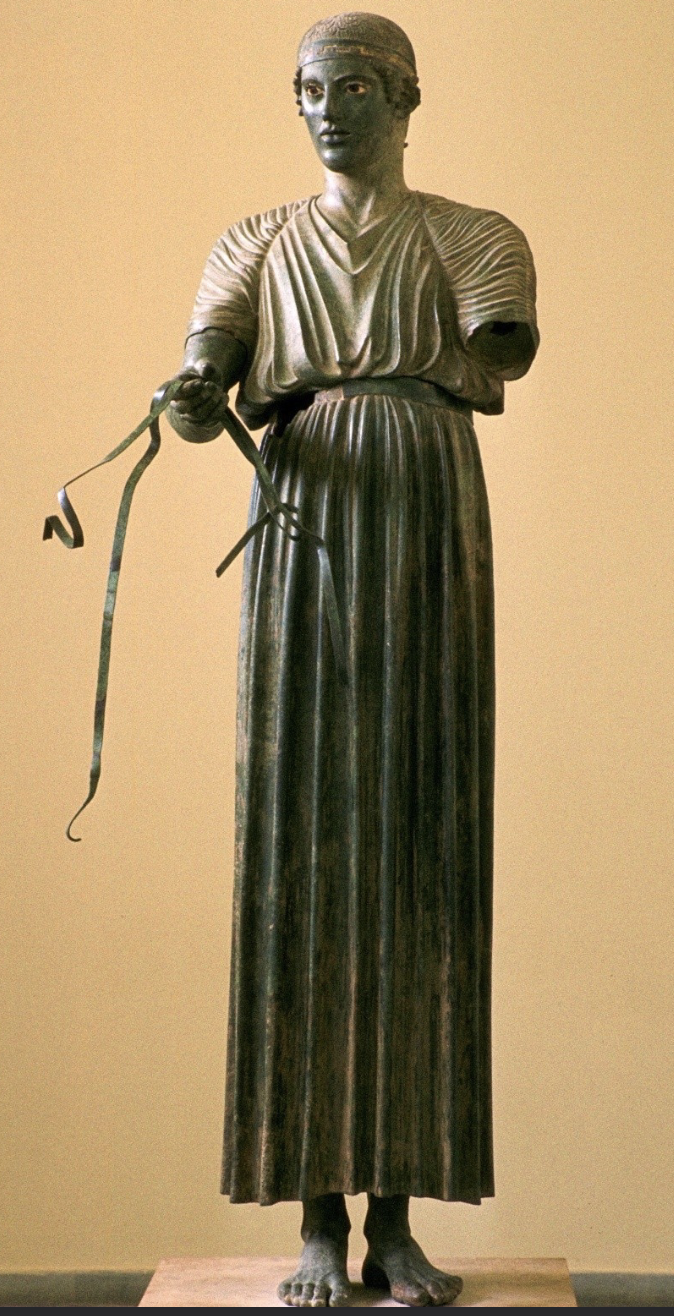
Delphi charioteer!
478-474 BCE
this is dedication by a victor
super duper realistic feet
but we still have some doughy drapery and puffiness
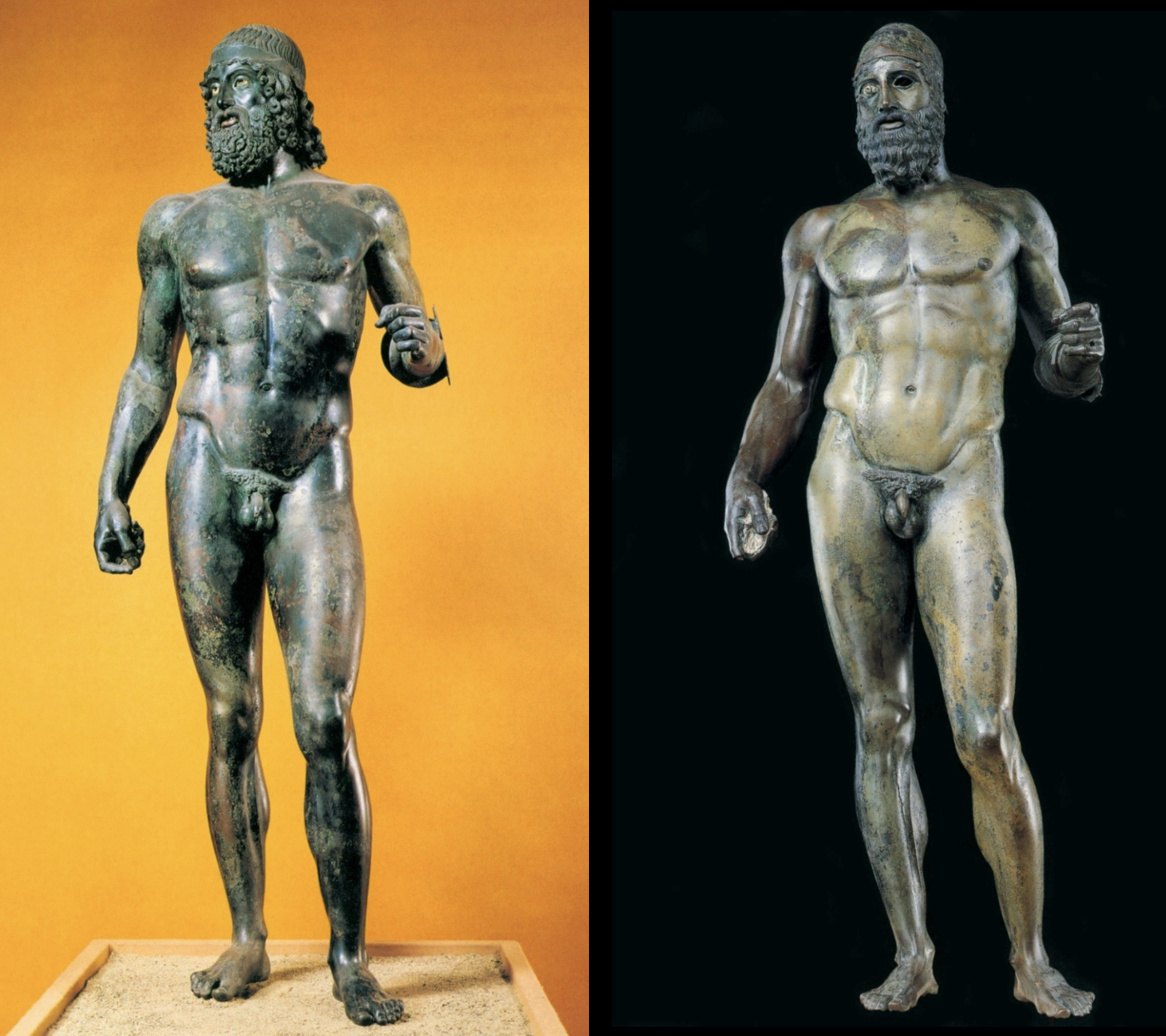
riace bronzes
460-450 BCE
from a shipwreck in southern italy
the color of the bronze itself on certain areas like lips and nipples would be different to make them pinker and more realistic
chryselephantine
ivory and gold
typically on cult statues
important sculptures to know!
phrasikleia
riace bronzes
delphi charioteer
pediments at temple of zeus in olympia and temple of aphaia in aegina
anavysos kouri
kritios boy
twin kouri
important ceramics to know!
vapheio cup
francois vase
cup of nestor
reveller’s vase
achilles and ajax playing a game
dionysus and the maenads
warrior vase krater from mycenae
important buildings to know
such as temples, treasuries,
treasury of Minyas (egyptian decorative motif!) (and has similar construction to treasury of atreus)
temple of aphaia at aegina
temple of zeus at olympia
keirameikos cemetery outside athens
pelopeion outside olympia
lefkandi heroon
temple parts to know
doric vs. ionic: see below!
pediment: both have this (chunky triangular part with sculptures
doric:
metope: spaces in between the triglyphs
triglyphs: 3 part things
frieze: ionic!
different styles to know!
palace style: swirly flowers
pictorial style: think clomp clomp cartoon
protogeometric pottery: swirls and geometry
dipylon pottery: 5ft funerary vase
geometric pottery
daedalic style: NE influence, sphyinx
protocorinthian pottery
protoattic pottery
doric vs. ionic
conflicts to know!
Persian Wars
Ionian Revolt
Battle of Marathon
lowk Delian league can be included in this too
delian league=
founded in 478 BCE
coalition of poleis
the persians aren’t here but they could be…be must be prepared!
the treasury was put in delos bc it was considered neutral territory like not in any polis’s home turf
potters and painters to know!
Pheidias
The Berlin Painter
Pioneer Group
Euthymides
Euphronios
Ergotimos
Kleitias
Amasis
sophilos
Let’s look at the passage of time through ceramics:
LH 1: matte paint, minoan influence
LH 2: lustrous paint, goblets, minoan influence,
LH 3: linear, pictorial, deep bowl appears, whorl shell motif, goblet is out but kylix is in
kerameikos cemetery:
early athens cemetery
we get first evidence of protogeometric pottery from here
also dipylon pottery (the huge chunky funerary thing)
lefkandi heroon/cemetery
super super large apsidal building and exceptional for the time
potential forerunner to greek temples of future
mid 10th cent. BCE
cremations and horses
lots of burial goods
heroon=tomb of hero
authority shown through connections to past
#groupidentityvibes
killing horses to be buried with those people shows how important those people were